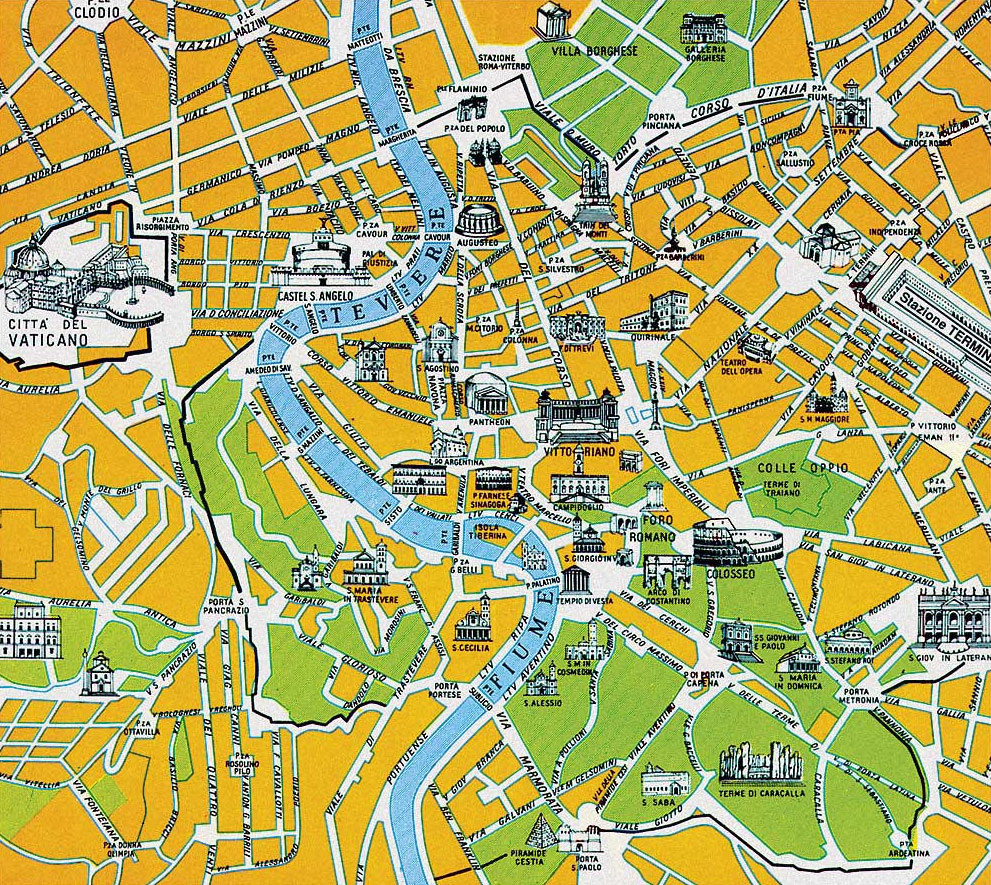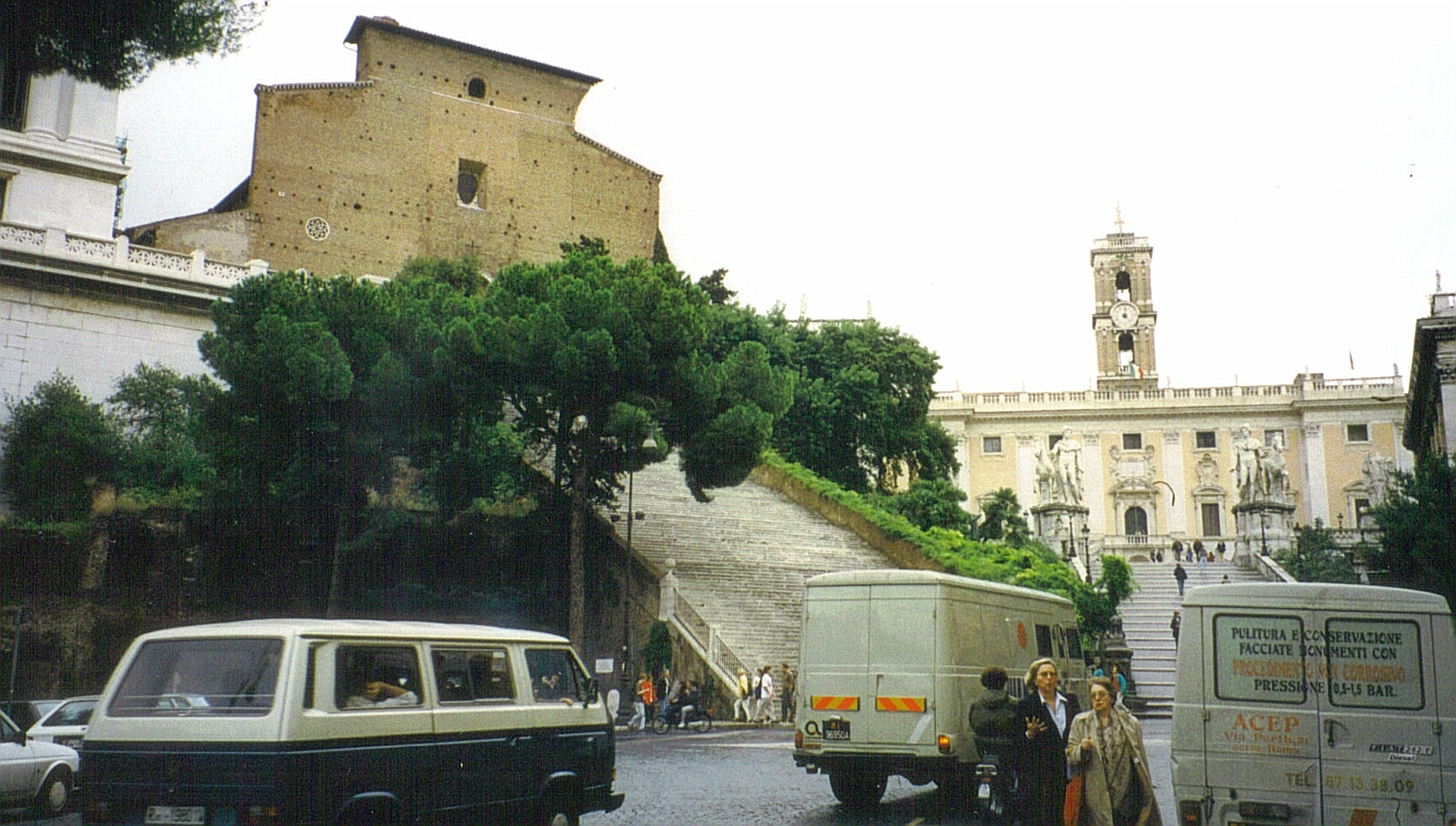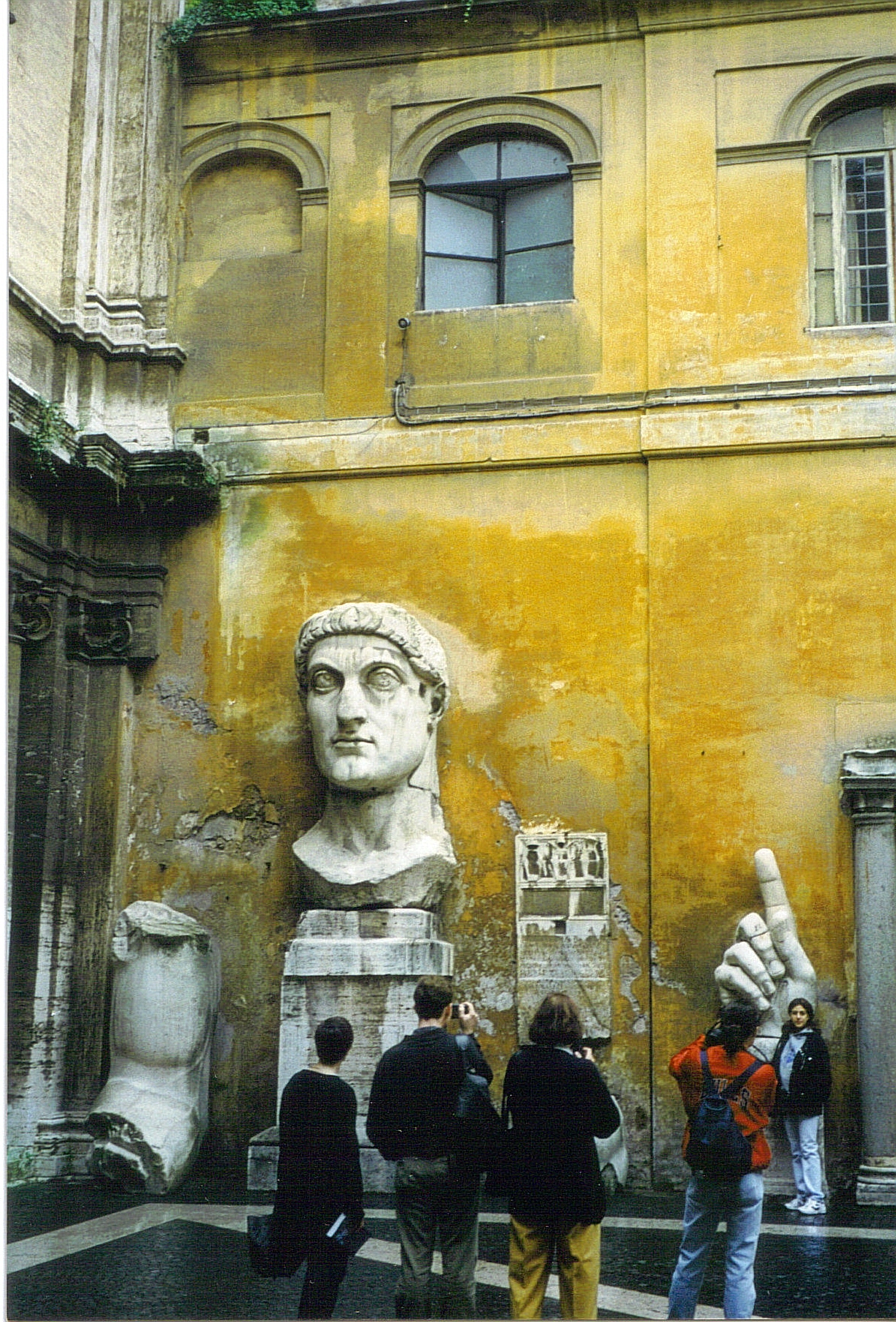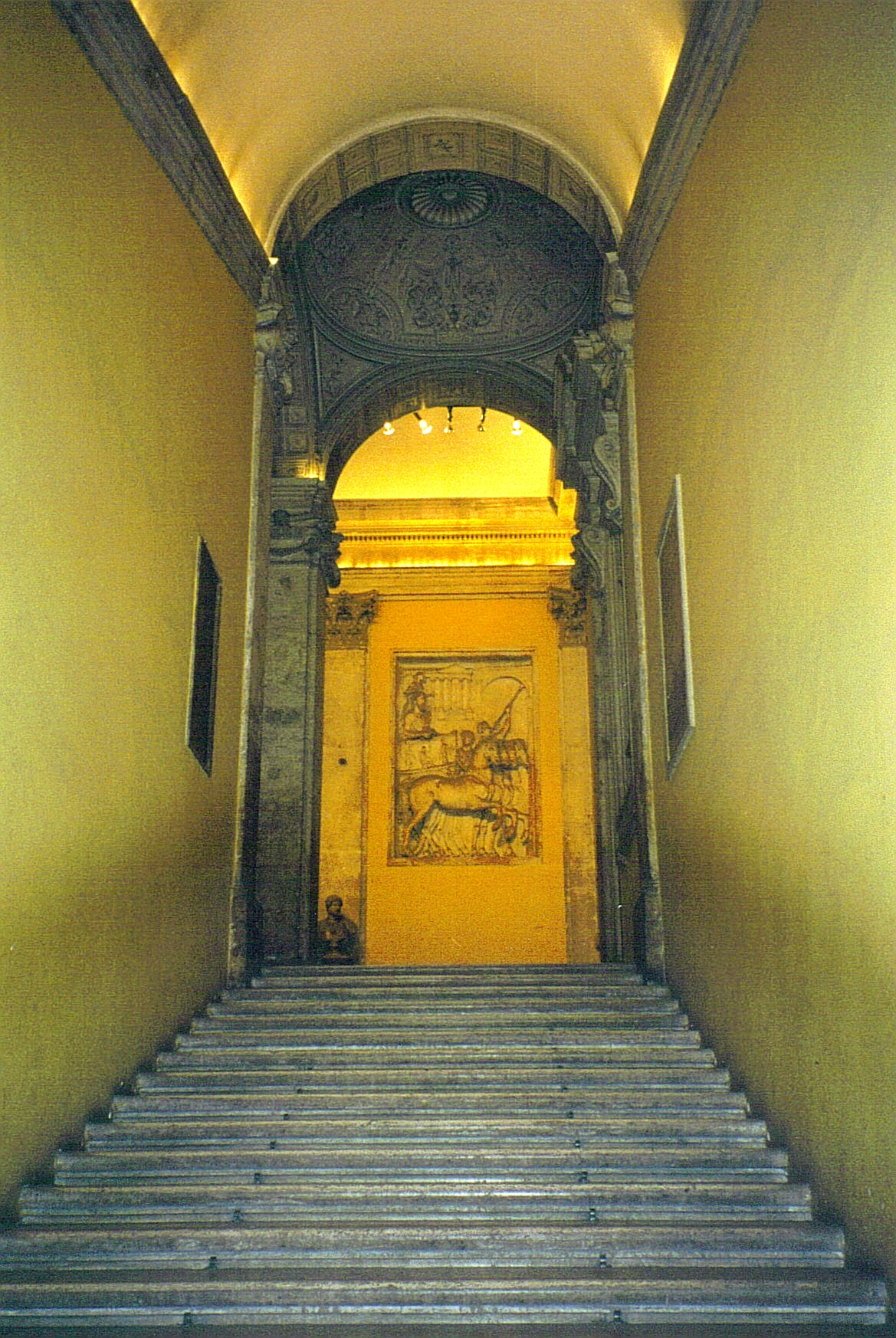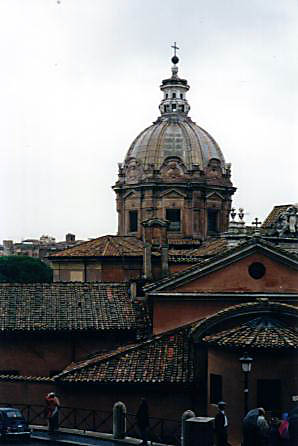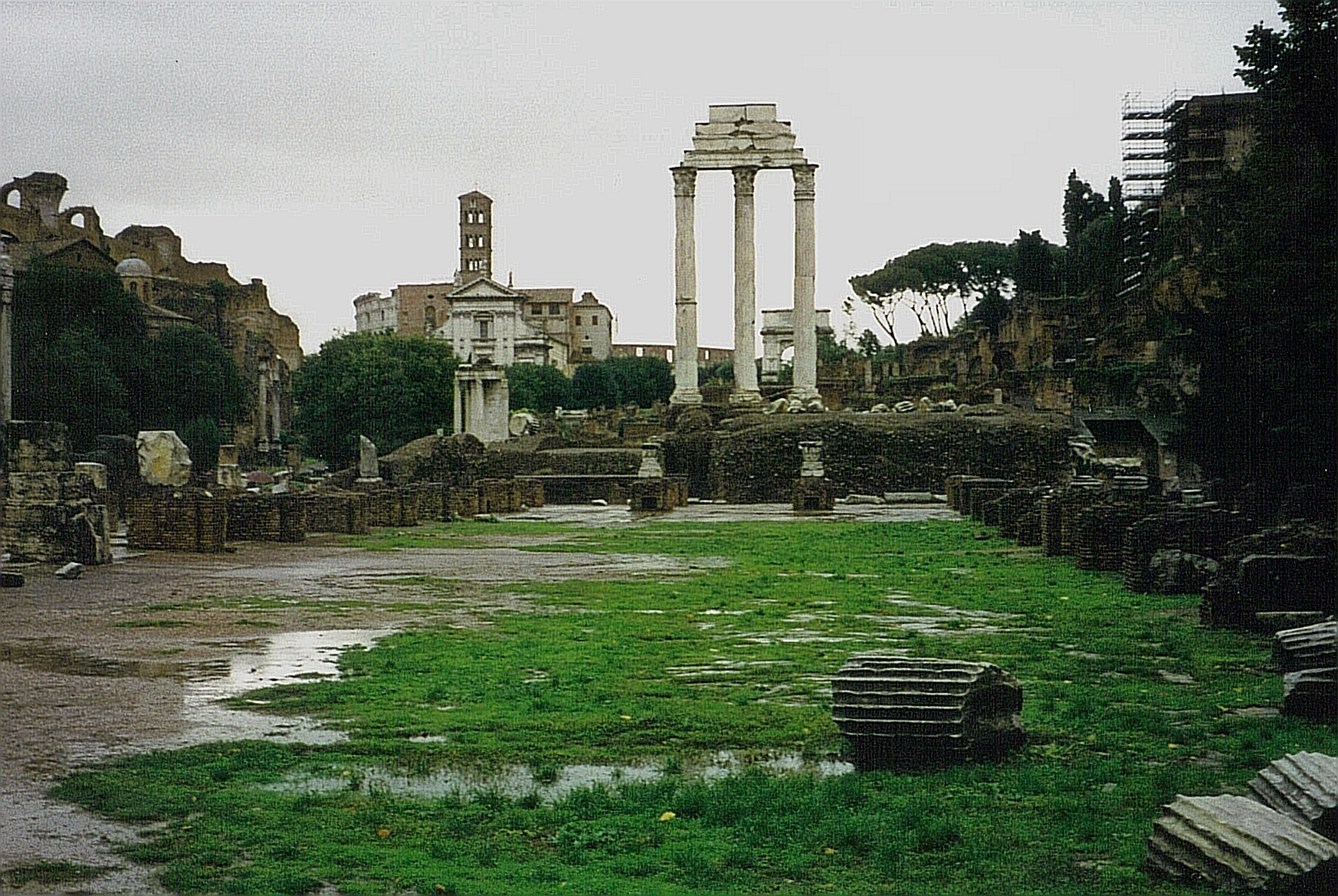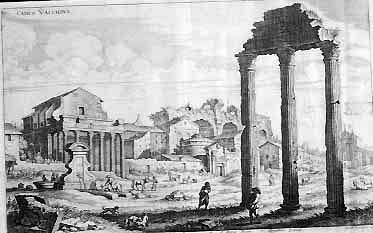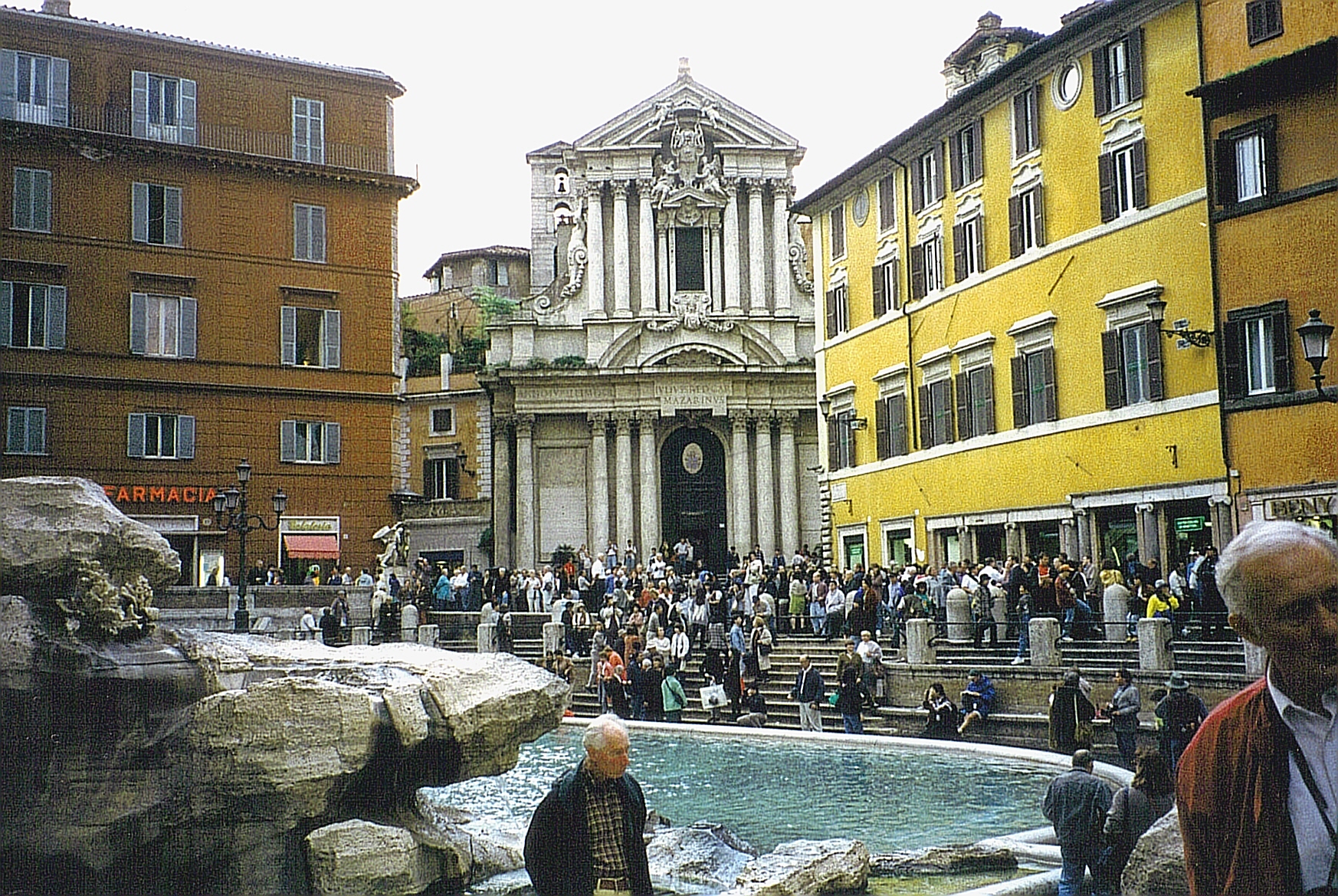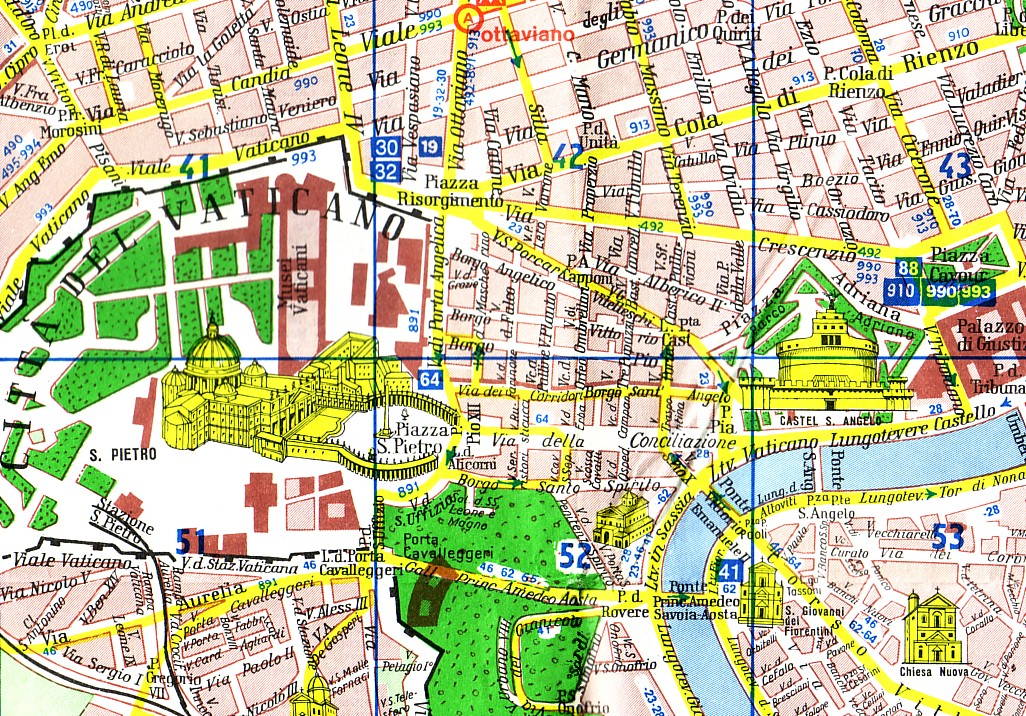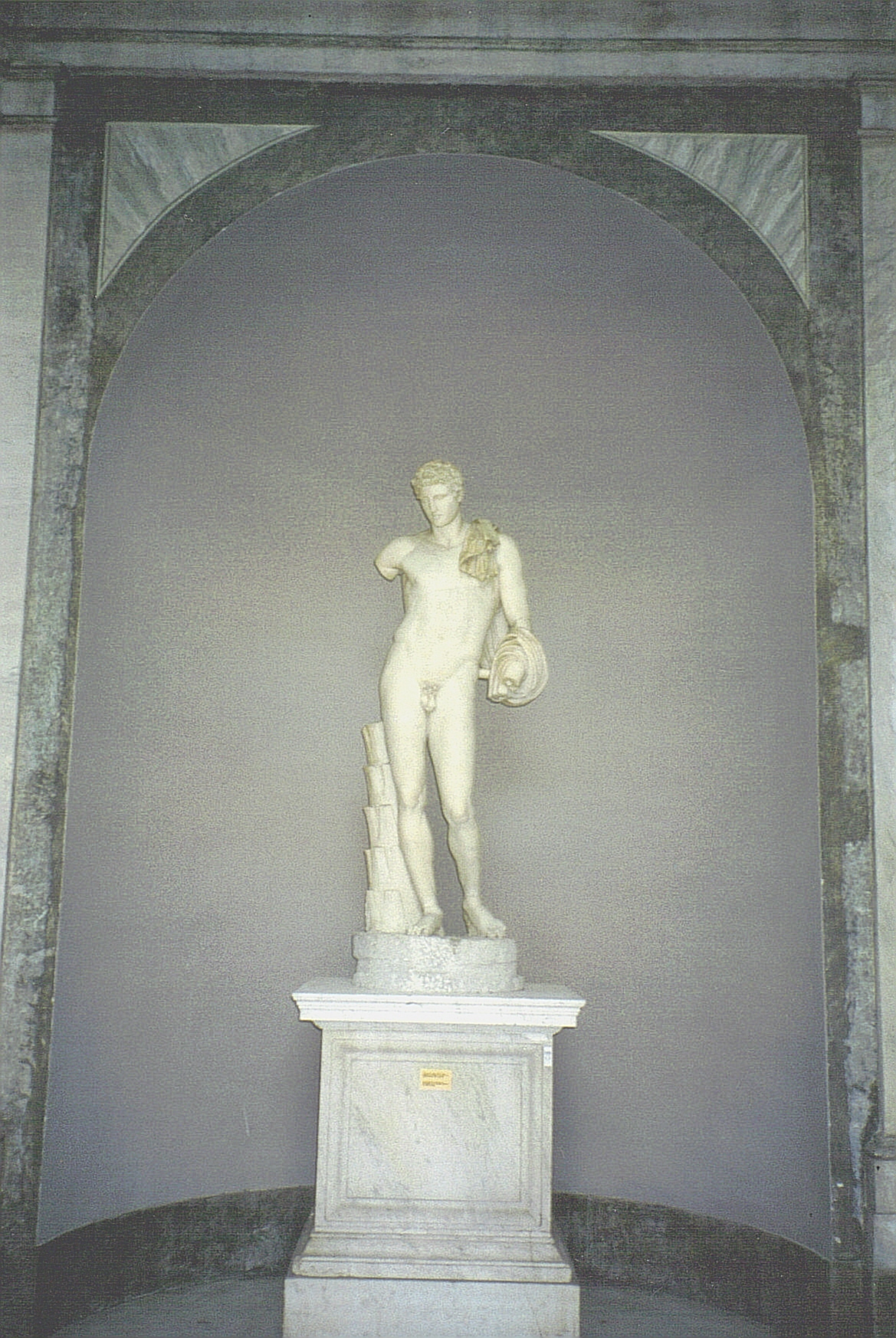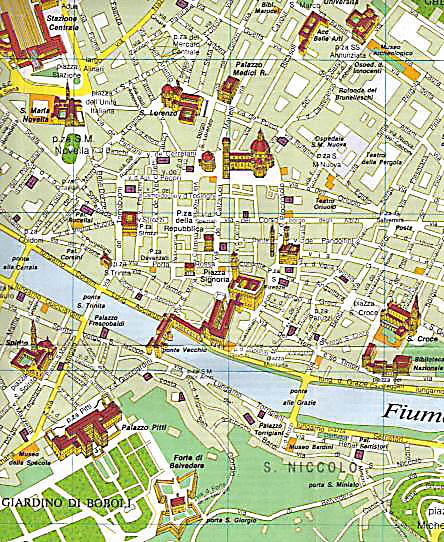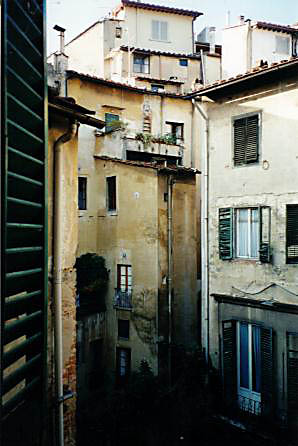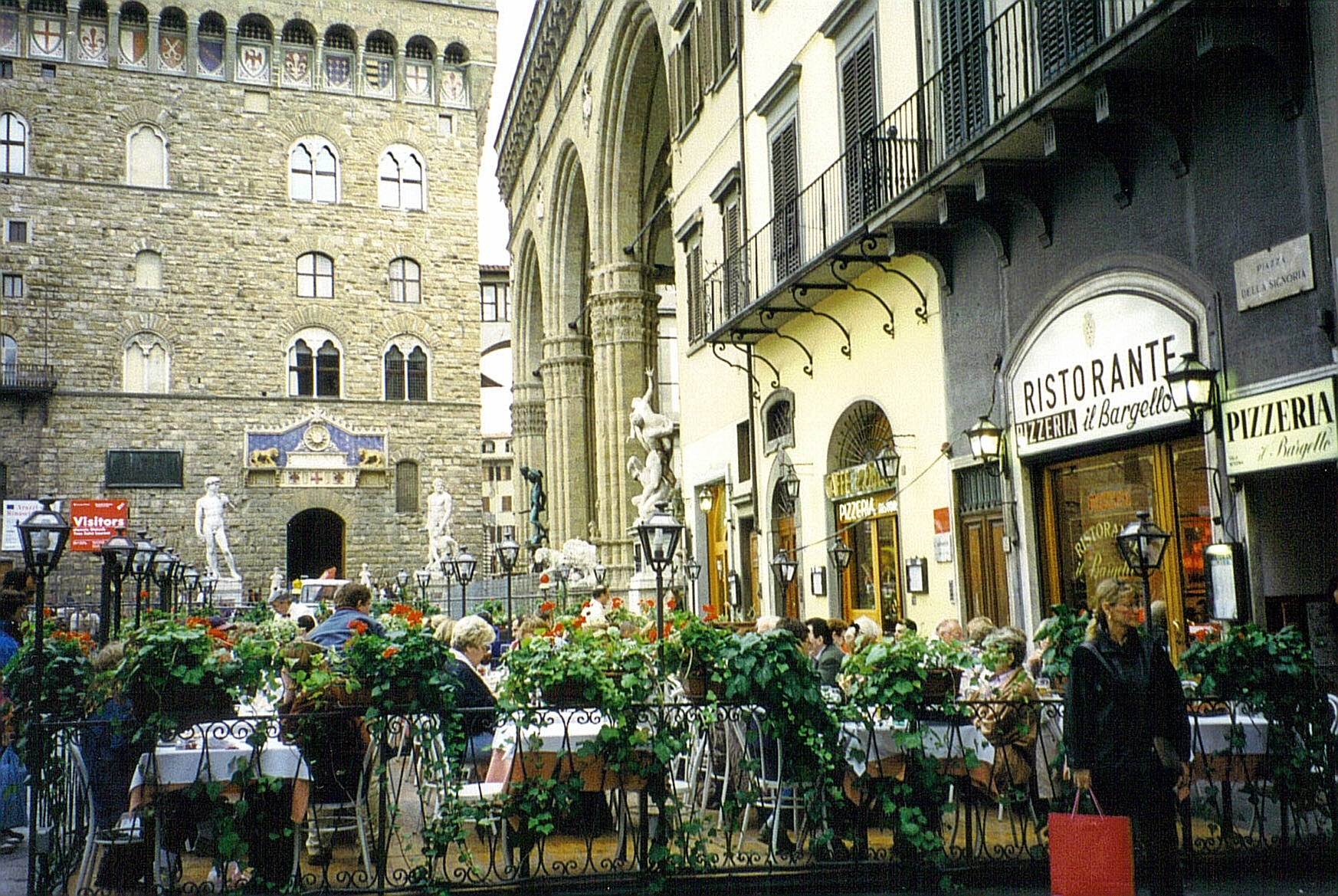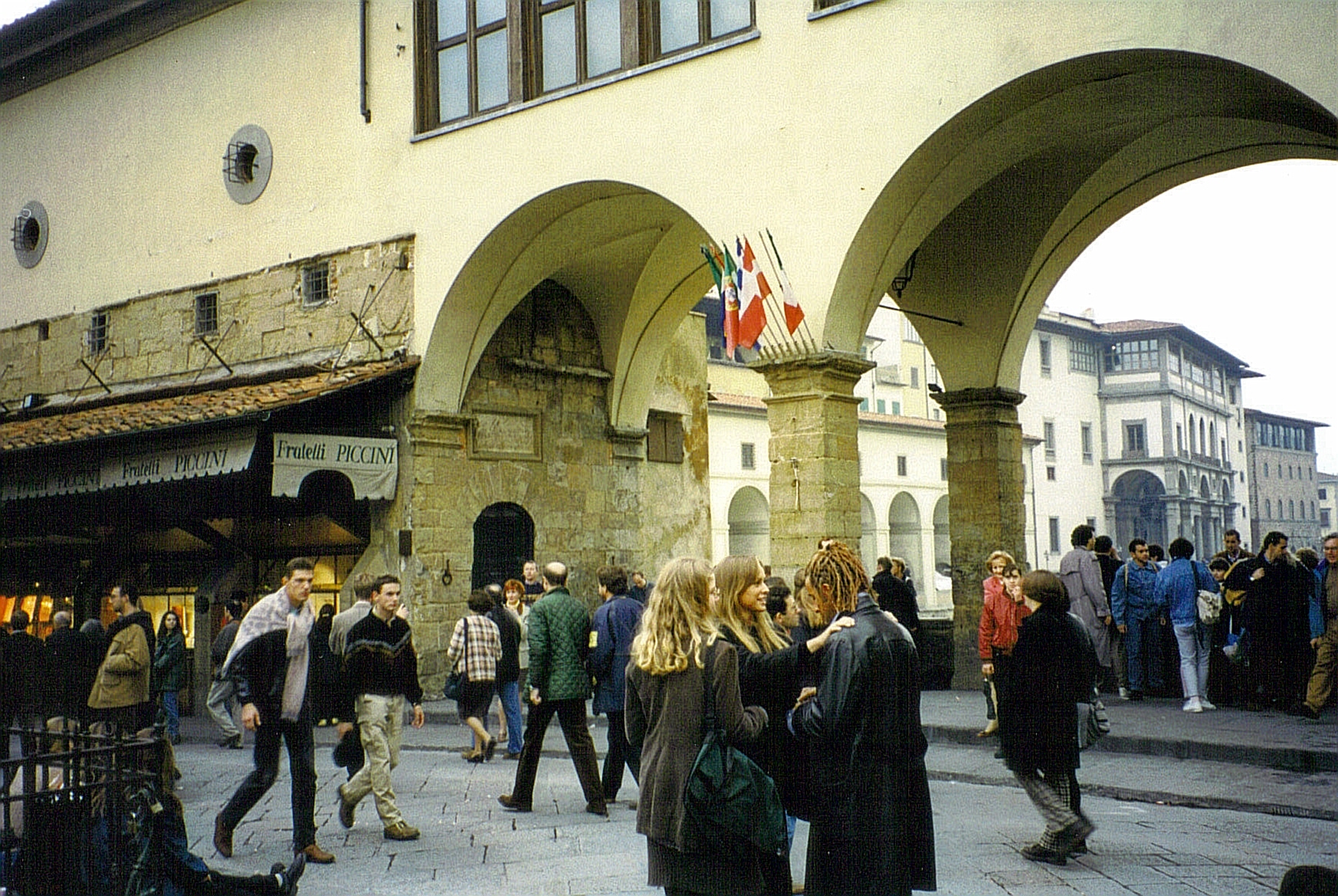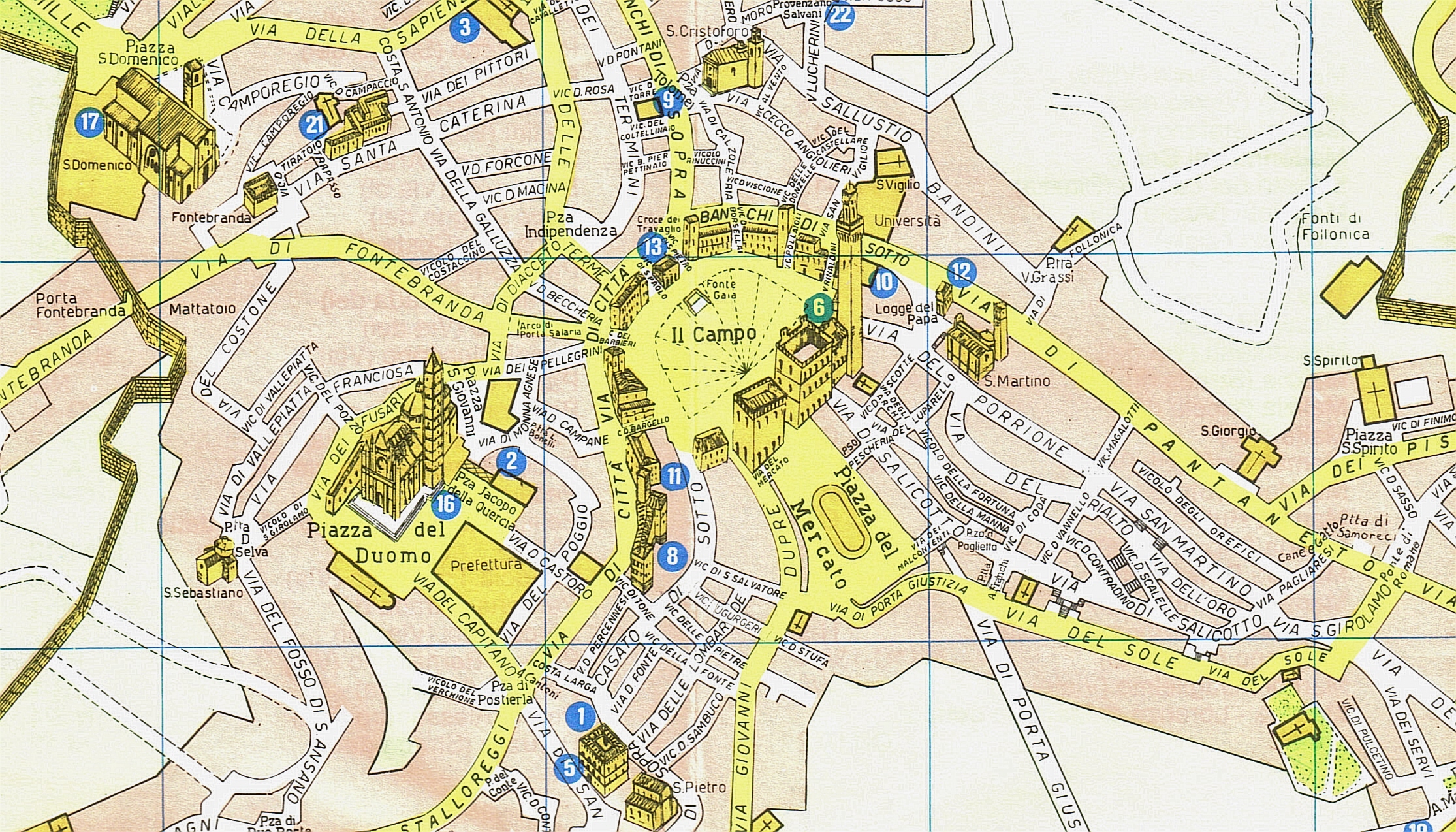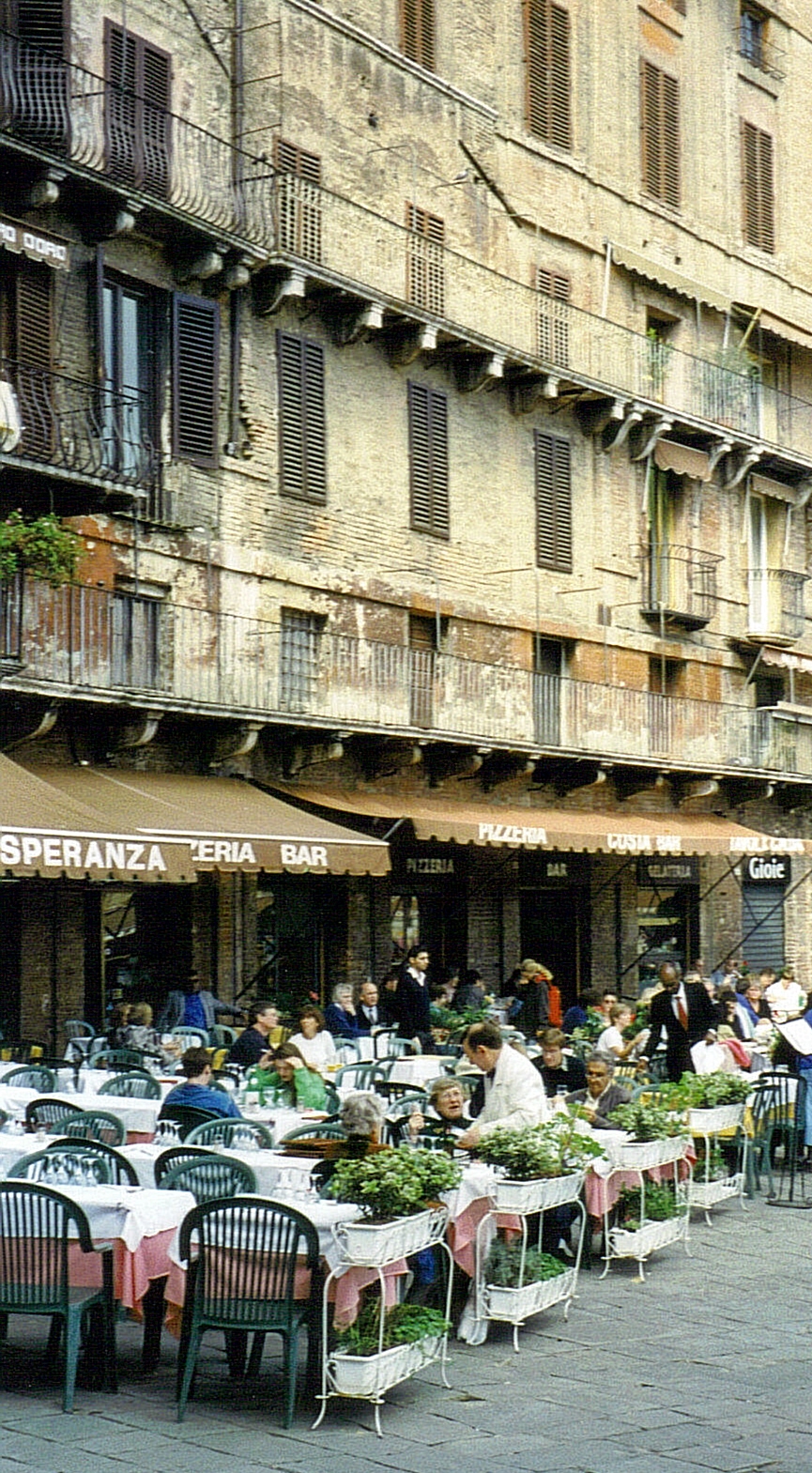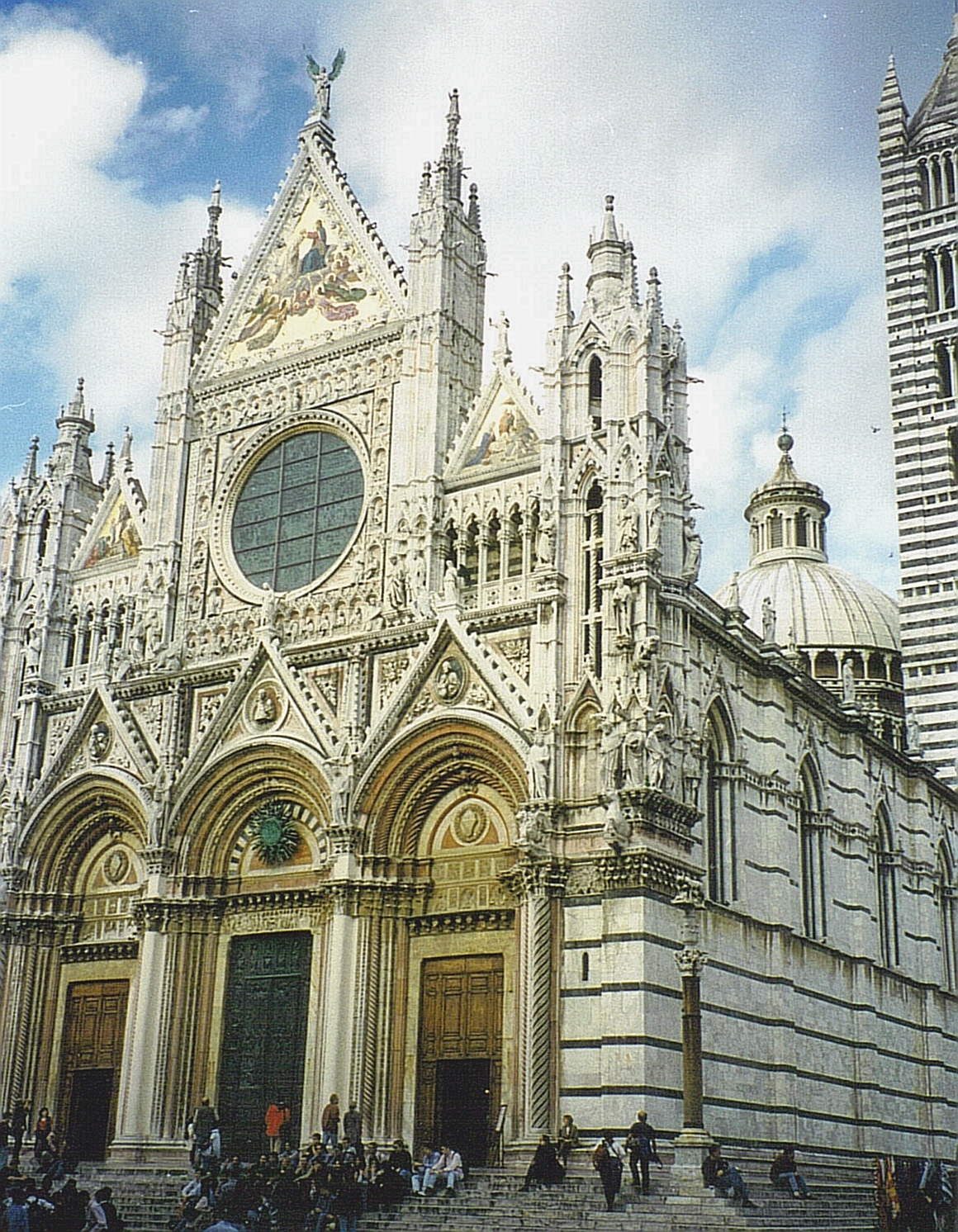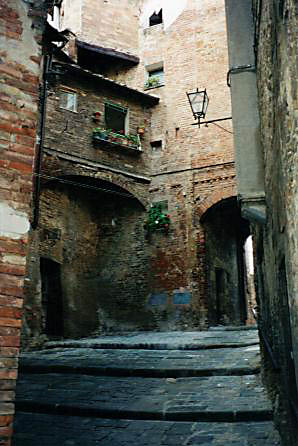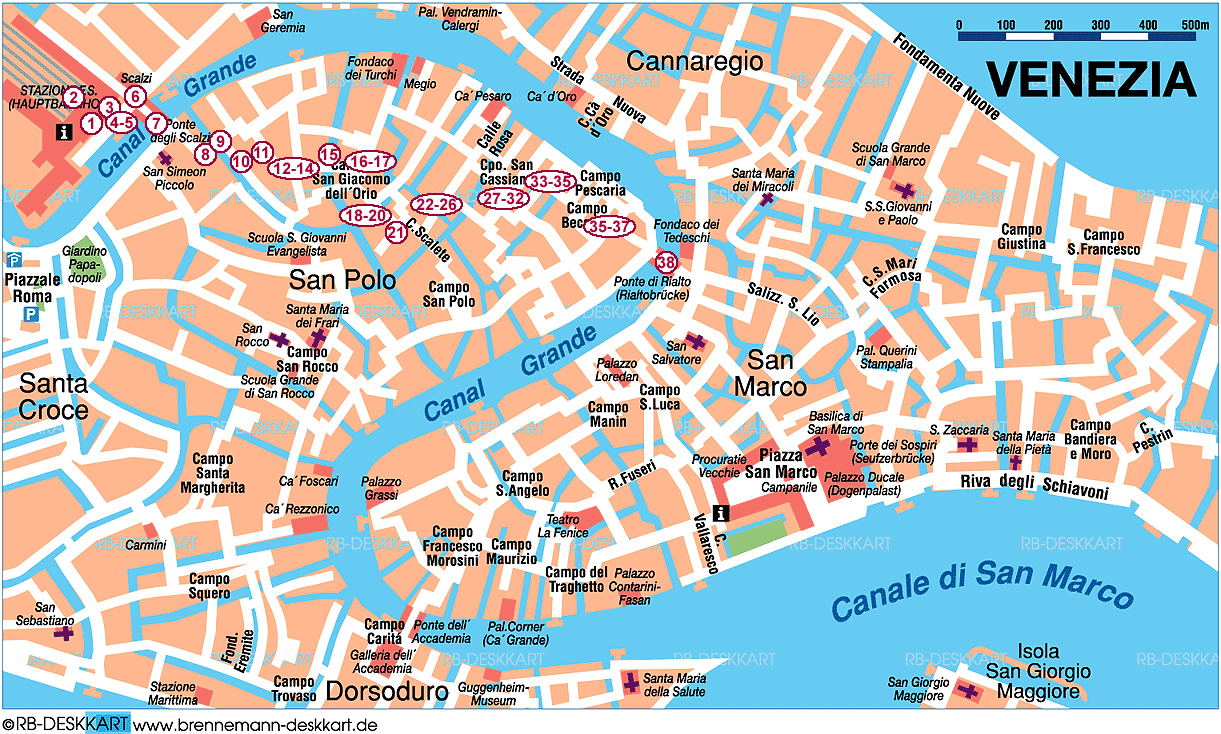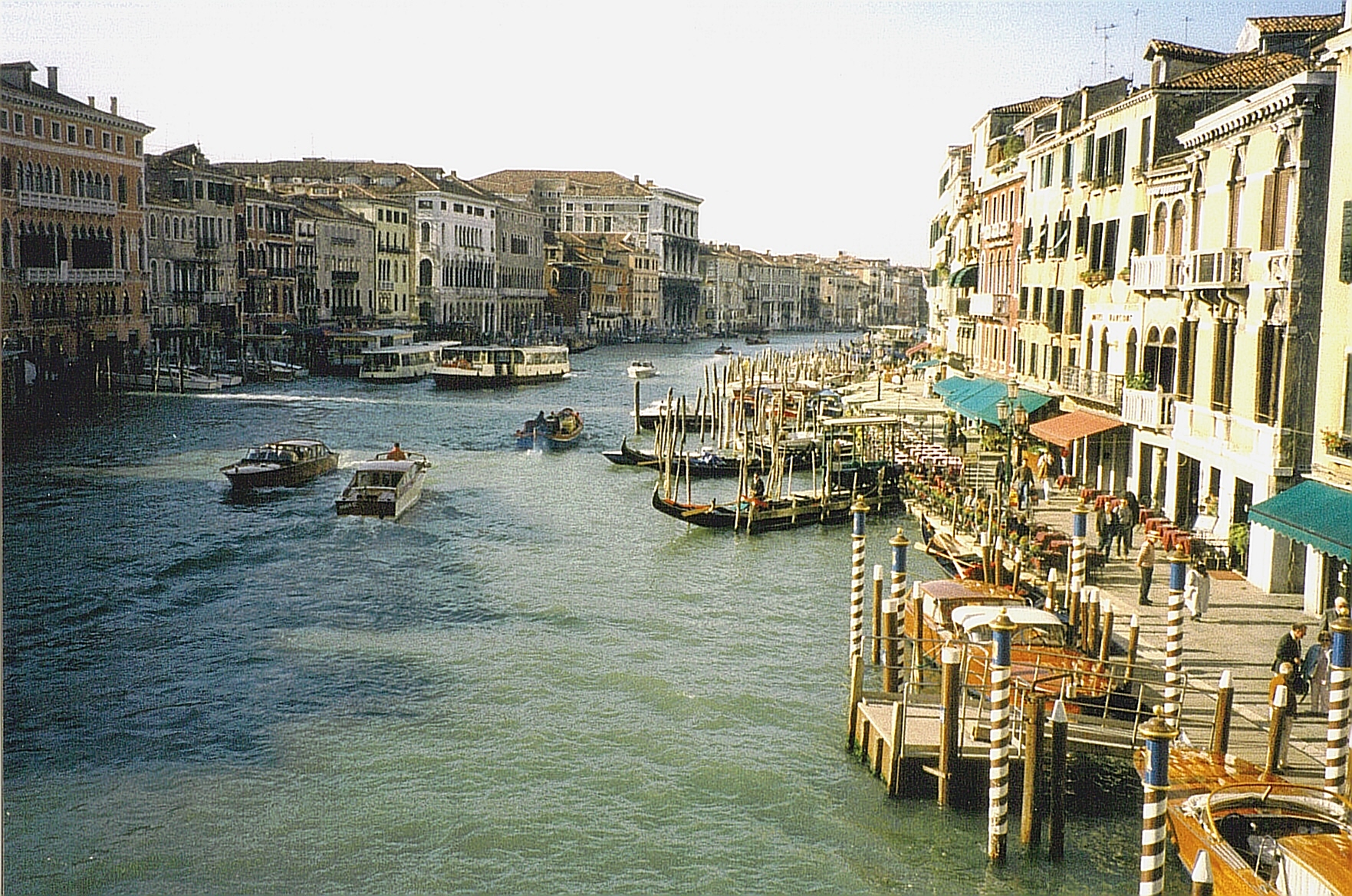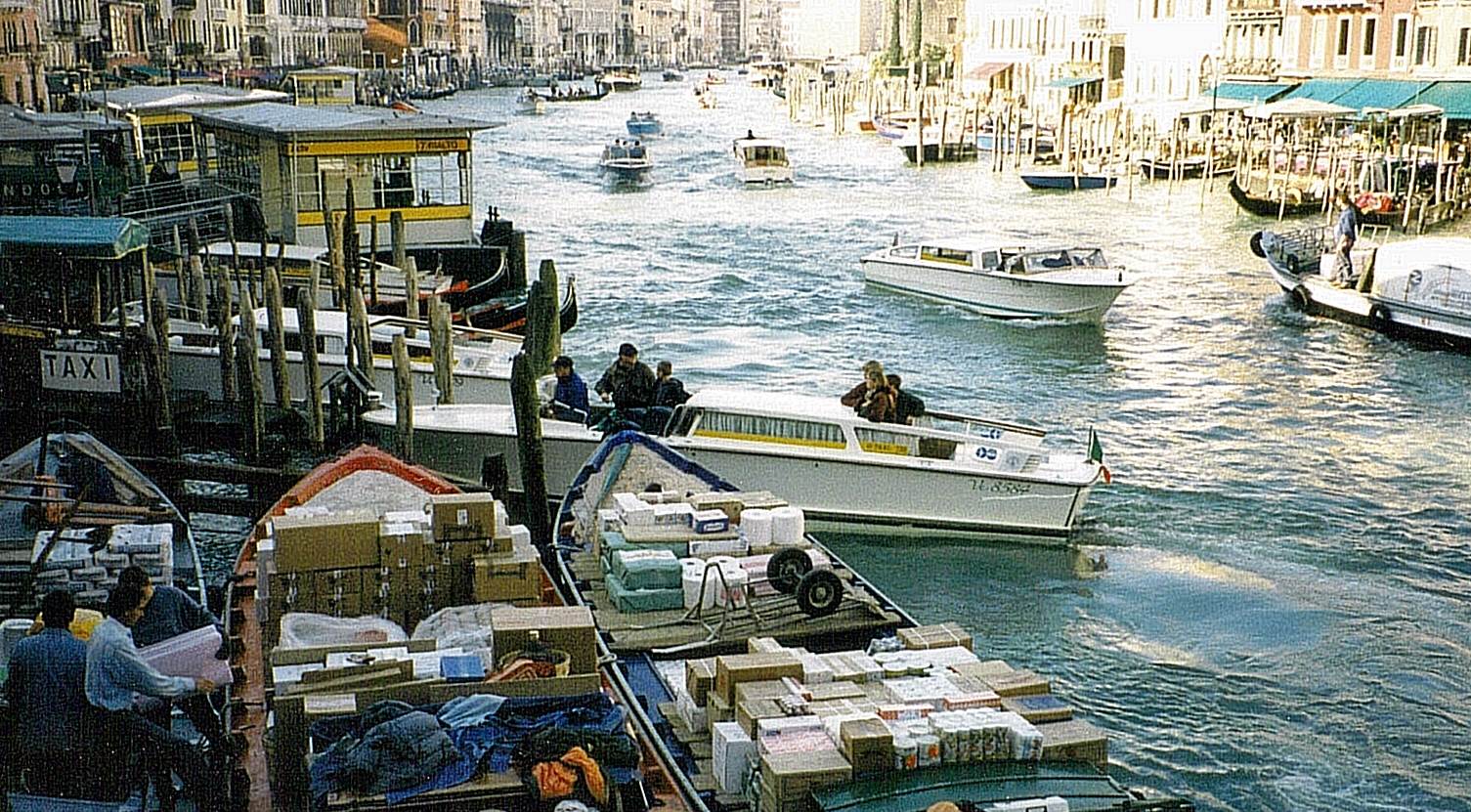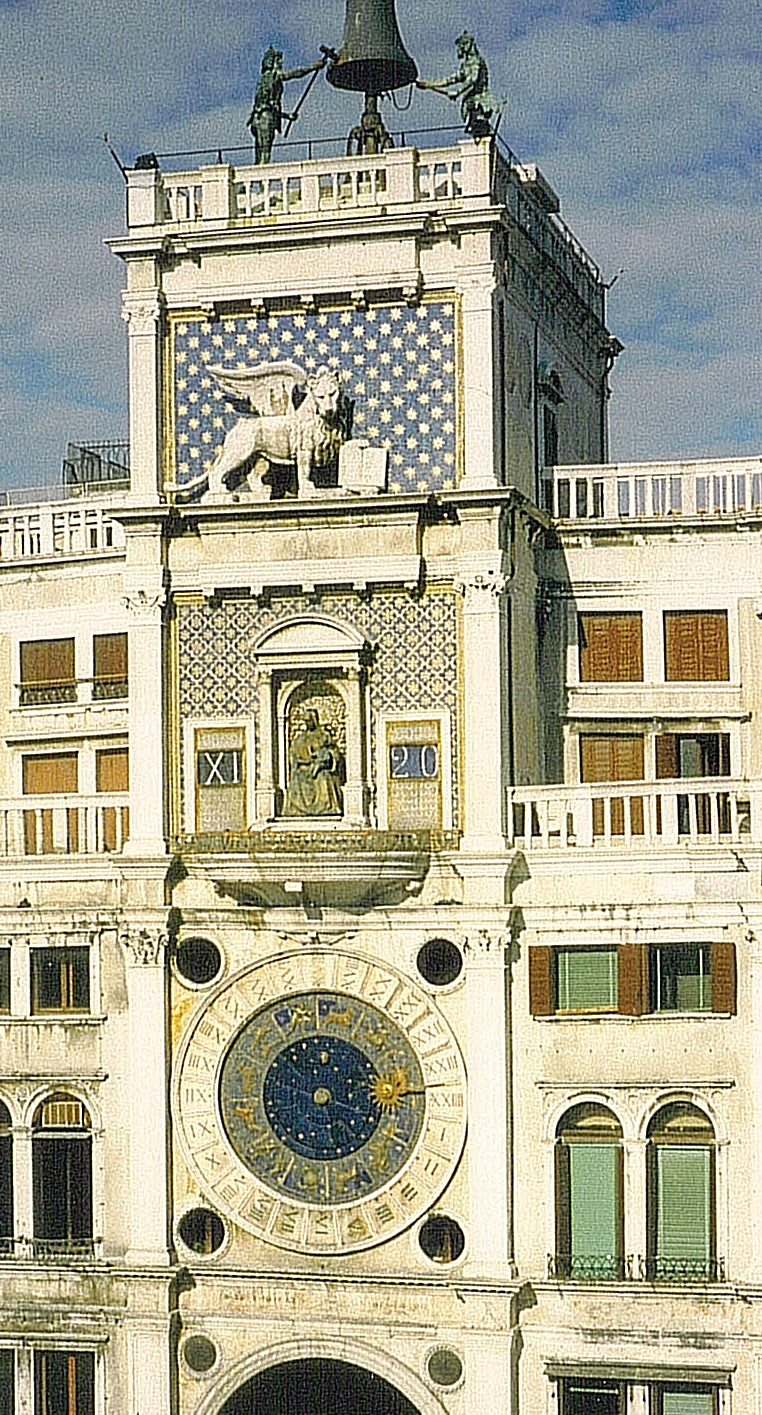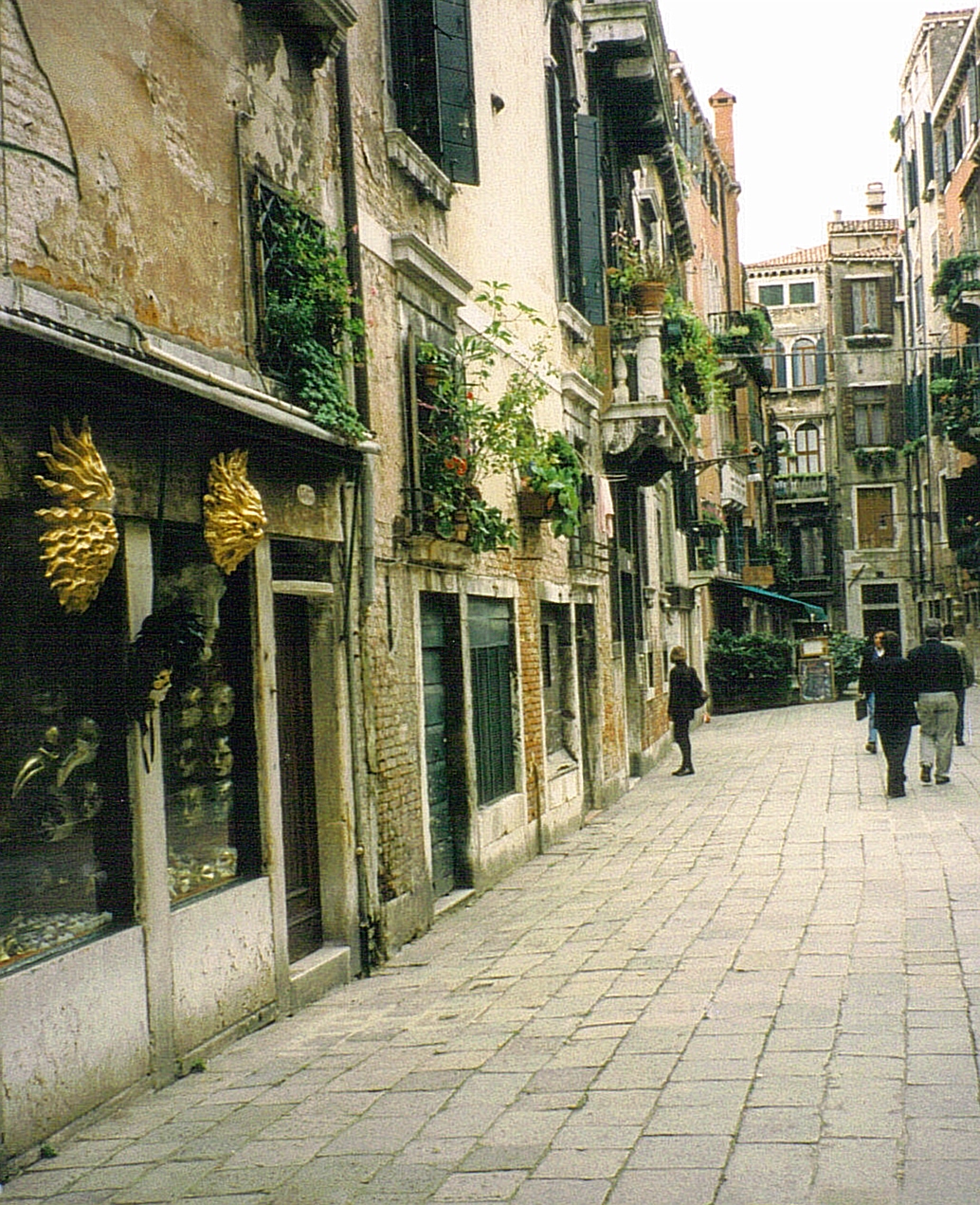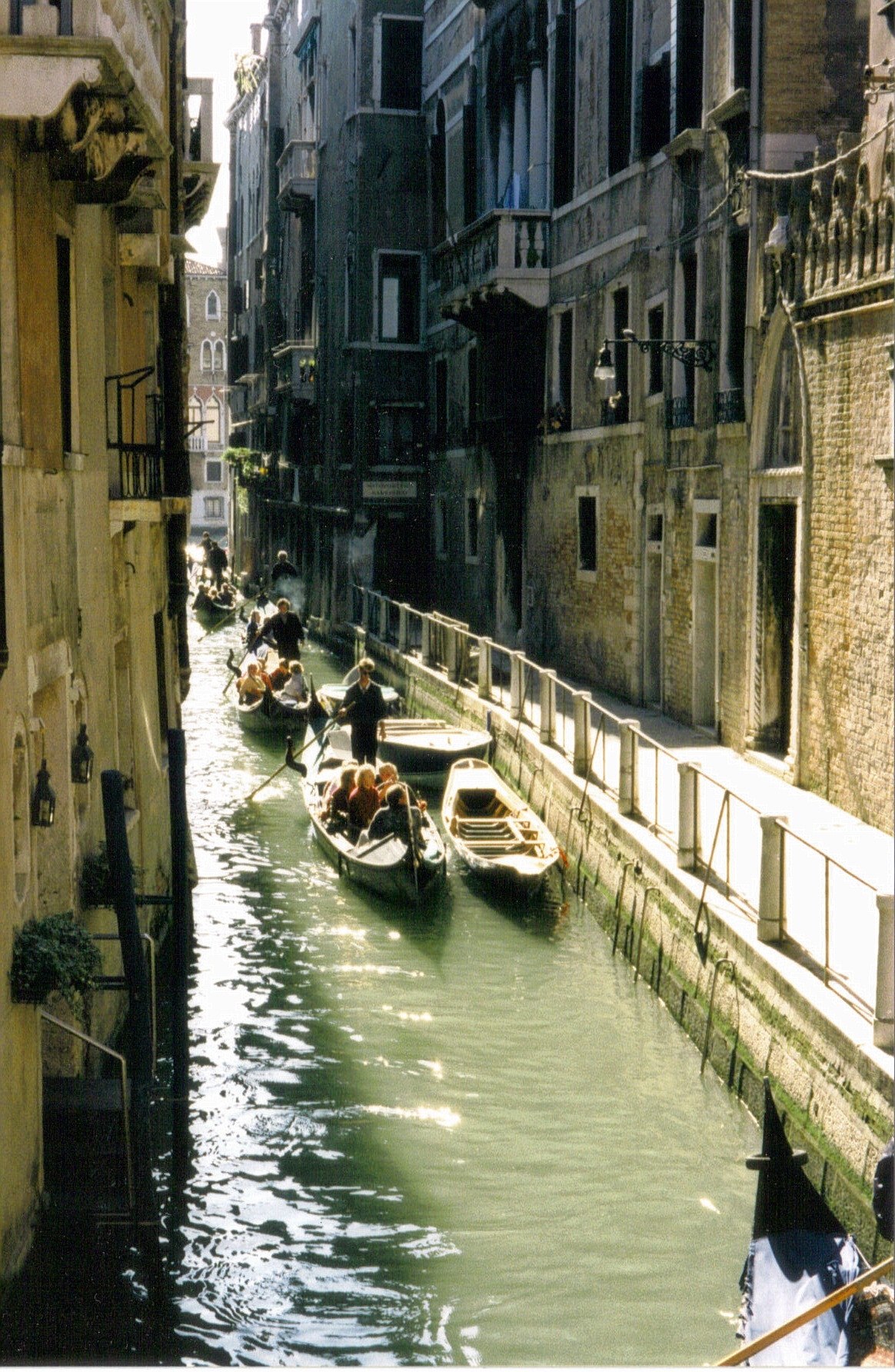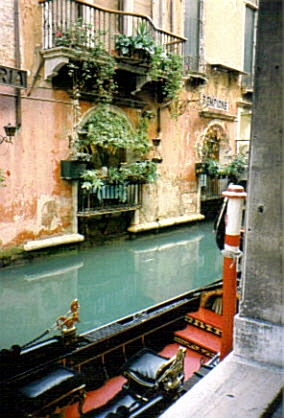Steve Watson
Information: Travels: Italy: Diary
|
14/10/1996 (Monday)
|
|
|
Arrived in ROME.
Landed at Leonardo da Vinci airport and managed to find my way to the airport railway station. The train ticketing system was a bit challenging, but I eventually worked it out and got a non-stop into the Rome Termini station (two grid squares East of the Quirinal on the map). As soon as I arrived I dropped off my bags at the left luggage and went looking for a hotel. After a couple of hours walking about I began to think that perhaps I should have bought a map first. The walk gave me a reasonable introduction to the layout of the central city though, and eventually I did find the Smeraldo. It's a decent little place near the Campo di Fiori, but there was only a double available and at L120k per night that's a little expensive for a budget traveller. I thought I'd be able to look for a cheaper place the next day.
|
|
|
|
|
|
Map of Rome The historical centre according to a tourist map I bought there. |
|
|
There was plenty of the day left so I went for another more leisurely and less focussed walk. It's fun just writing the names of the places I visited: the forum, the Campidoglio, Piazza Campo di Fiori (a great disappointment - no flowers), Largo Arenula, Largo di Torre Argentina and environs. I went into the Chiesa Aracoeli, but that was impressive only in virtue of its mass. My first impression of the city wasn't that favourable: I thought it was rather scruffy, and the ancient sites seem uncared for and somehow uninspiring. But perhaps that was just an effect of travel fatigue combined with the overcast conditions
|
|
|
15/10/1996 (Tuesday)
|
|
|
This day I walked forever. First, back to the Campidoglio and went through the two museums flanking it, the Palazzo Nuovo and the Palazzo dei Conservatori. I spent ages in there and it was quite as good as the guidebook had promised. I was pleased to see the 'Dying Gaul' statue. Special mention should also be made of the collection of heads of Socrates, not all of which are so labelled. In fact a lot of the labelling looked pretty odd to me. There were several that I would have questioned - but I suppose that the Romans would know about this stuff if anyone would.
|
|
|
|
|
|
Santa Maria in Aracoeli On the left: Santa Maria in Aracoeli and steps by Cola do Rienzo (1348) On the right: the Cordonata steps by Michelangelo to his Piazza Campidoglio, passes between the statues of Castor and Pollux. The Palazzo Senatorio behind is Rome’s town hall. The hill on which these all things stand is the Capitoline. Note at lower left an obscure Roman ruin and above it is a corner of the Vittorio Emmanuele monument (a ridiculous pile).
|
|
|
|
|
|
Constantine’s Head Pieces of the Emperor Constantine in the Palazzo dei Conservatori Museum flanking Piazza Campidoglio. Actually it's outside the museum - which is odd.
|
|
|
|
|
|
Palazzo dei Conservatori The entrance steps.
|
|
|
|
|
|
S. Pietro in Carceri The Church of San Pietro in Carcere (in prison) where Saint Peter was held prisoner – actually in the Mamertine prison upon whose site this church was built. The road is the Via del Monte Tarpeio which leads past the Tarpeian Rock (traitors were thrown from here in early Republican times). |
|
|
From there I made my way up to the Tarpeian Rock and the road it supports, and then back down and eventually into the forum.
|
|
|
|
|
|
Forum Romanum |
|
|
I spent several hours exploring the remains of the forum. With the light rain that was falling, the ruins of the huge buildings and the knowledge of the Empire that had been built here, it inspired agreeably melancholic reflections. These certainly look like the buildings that the Masters of the Universe would build for themselves; and I could also sympathise with the barbarian poets who could only imagine that giants built these things ('Well-wrought this wall: Wierds broke it ...'). I bought a cheap umbrella (L5k) from one of the hordes of Senegalese hawkers that infest the streets of Rome. That, too, seemed appropriate.
I exited this via the Circo Maximo and from there moved straight on to the Colosseum (Anfitheatro Flavio). Which was a duty stop really. My feet were beginning to complain. In any case, the Colosseum is the symbol of everything which was despicable in Rome so I find it rather difficult to appreciate it properly as a sight. Looking at it, I'm still not sure whether Rome was, on balance, a good thing or a bad thing for civilization.
|
|
|
|
|
|
Foro Romano The remains of the forum. The three pillars belong to the temple of the Gemini, ie. of Castor and Pollux.
|
|
|
|
|
|
Campo Vaccino A old picture I found of the same scene before Romans began to care about their history. Artist unknown (and it doesn't look like Piranesi.).
|
|
|
I had a general plan to my movements: I needed to pick up my bags from Termini, so I headed in that general direction; but I began to find that Rome is full of distractions. I had to stop in at the Basilica di San Pietro in Vincolo where in the gloom I could just about see Michelangelo's 'Moses' (with the horns).
All this was very pleasant, but there was a nasty surprise when I got to Termini and found that my card wasn't linked to the Italian money machine system. So much for my prior preparations. I had to change some British money, but this was immediately consumed by a charge for left luggage which I did not understand. Finally I hired a taxi and took everything back to the Smeraldo where I'd moved into a single room for L85k per night. There are bathrooms on the same floor, so that's worked out OK. (Also, I watched an Italian TV show and recognised many of the Roman scenes. I feel quite the international traveller.)
|
|
|
16/10/1996 (Wednesday)
|
|
|
A general note: I walked through a good many bookshops on this day - both new and used - and found nothing interesting. I resolved then not to do any more of that. (My hopes were raised by a friend who'd years ago sent me an hilarious old Italian history of the world from the time of Noah's Ark that she'd found in a Roman shop.)
The first thing I did was to go to the Credito Italiano (somewhere on the Corso Vitorio Emmanuele) and get a cash advance for L450k, the maximum allowed, which was much easier than I thought it'd be. I also extended the time I'd be staying here so that I'd be leaving on Friday. I did a lot more sightseeing by just walking around, and rather less in the way of going into museums. On my first outing I did, however, go into the Chiesa della Gesù (NW of the Typewriter in the Piazza of that ilk) where there is the tomb of St Ignatius Loyola. (It's a Jesuit church built in the Baroque and as overdone as only that period could manage - but it's certainly not the style I would have associated with the Jesuits). I spent much more time having a brunch in a small cafe while reading the 'Guardian'. Very civilised. Then back home.
After a rest, I went out northwards to see the Pantheon. It is an impressive and beautiful building. The inner space is huge. Because it had begun raining again it was perhaps more crowded than usual; and the centre had been roped off, I suppose because the water coming through the open top of the dome would make the marble quite slippery.
I walked up the Via del Corso (plus some side streets of course) to Montecitorio through some very fine shopping areas until I came to the Piazza Colonna, where there was huge column (surprise) surrounded by a moped park. I thought then that History was wasted on the Romans, but I guess if your whole city is an historical treasure, you do just have to get on with life.
|
|
|
|
|
|
Fontana di Trevi Tourists surrounding the Trevi fountain, and a view of the church of Santa Vincenzo ed Anastasio, at one time the personal church of the Popes.
|
|
|
The next sight worth seeing was the Trevi fountain, but it was quite crowded too. I became a bit disoriented here (it had to happen sometime) but I eventually found my way up the Via del Tritone and the Via Sistina to the Piazza di Spagna and the Spanish Steps. (The 'Barcaccia' fountain by the elder Bernini is very, very silly.) Those steps lead up, after some diversions, to the Church Trinità dei Monti, which is dull enough in itself but from which there are very fine views.
Behind the Trinità the road is lined with trees as it climbs further up the hill alongside the Villa Medici. It eventually drops you down into the Piazza del Popolo. If I had had more time I should have turned right and gone into the grounds of the Villa Borghese which is supposed to be quite beautiful. Next time perhaps? Instead I walked down to the Ara Pacis Augustae and the Augustan mausoleum - and by now I really just wanted to find somewhere to sit and eat. Approaching my base nevertheless in a rather roundabout fashion I went down the Via dei Coronari to the Tiber river (The Tiber!) and along the Lungotevere back to the Campo di Fiori. I was too tired to remark on much that I saw on this part of the walk, but I did happen to look inside the Palazzo Farnese (the French Embassy) as it was now night and they had their lights on. (Naturally, Michelangelo worked on the building - he seems to have had a hand in just about everything.) I noticed the rather fantastic ceiling, and I wonder if that is the one painted by Caracci.
I had dinner outside in a small cheap and pleasant restaurant in the Campo: pollo diavolo with some rather rough red wine
|
|
|
17/10/1996 (Wednesday)
|
|
|
This was possibly my most rewarding day in Rome, though it started badly. I had walked up to Termini and beyond, to Via Varese, to find a place which (according to my guidebook) prebooks places. I was misinformed. Well, these things happen. I took the opportunity, however, of touring the Diocletian Baths, and that was brilliant. The ruins are just huge. And they provide good shelter from the rain too.
From there I went through the Piazza Barberini and down Tritone etc. to Santa Agostino. It's a dark little church but in one corner you can pay to turn the lights on to see a Caravaggio. I suppose that's reasonable. Then off to the Piaza Navona. They say you'll always wind up here, but I was looking for it the previous night and managed to walk right round it.. Anyway, I had lunch here watching the people in the best cafe lizard fashion, then I went off to see St Peter's.
|
|
|
|
|
|
Città del Vaticano An independent city within Rome. I sent a postcard to a Catholic friend with the Vatican City postmark on it.
|
|
|
St Peter's exceeded my expectations. It is much larger than I thought it would be, and much more beautiful. It really looks worthy of being the centre of an Imperial Church. The ancient Romans would have appreciated the grandeur. Truly awesome. Naturally I did the sights there: Bernini's Big Bronze Baldachino (using bronze liberated from the Pantheon as I recall - you have to be pretty confident in your own worth to consider committing that sort of vandalism), Michelangelo's 'Pietà' (rather over large, but still quite intimate), etc. I also went up into the cupola for a view over the scene. I thought I'd save L1k by using the steps rather than the lift, but this was a mistake that I came to regret. The thing is miles in the air, so that you can see all of Rome, and it takes ages to walk and climb all that way. And some of the way is along narrow corridors that seem to lie on their side to follow along the top of the dome, which makes it a very uncomfortable walk as well. There was also a bit of clambering about on the rooftop. You really don't expect that sort of thing in the Vatican where there are millions of visitors (my guess) each year.
|
|
|
|
|
|
Apollo Belvedere The Apollo of the Belvedere in the Pio-Clementine Museum in the Vatican. At one time held to be the very pinnacle of the sculptor's art.
|
|
|
Having made my way down from the top of the Roman Catholic Church, I then had another long trek to find the incredibly poorly signposted Vatican Museums. But it was certainly worth the effort. I finally saw many of the famous works of art that I'd read about and seen photographs of, and it's always different and exciting to see the real thing. I walked through the Pio-Clementine with its 'Apollo Belvedere' and 'Laocoön'. It was worth the price of a ticket to Rome just for that. I saw the 'School of Athens' in the Raffaele Stanze. The left side was being worked on so that wasn't so good, but I was virtually alone and that was more than enough compensation. There obviously pros and cons to coming in the off-season. The museums had fascinating collections of Egyptian, Assyrian, Sumerian objects, and some very interesting seals and cones from Lagash (the first Sumerian objects I think I've ever seen directly.) There were long, long corridors with huge painted maps on them and beautiful tapestries (not that I care much about tapestries, but still...).
Finally, in this account, I saw the Sistine Chapel. Surprisingly enough, this was actually a bit of a disapointment: I didn't like it. Too dark. Too busy. Just, too much. (As the Emperor Frederick might have said 'Too many figures, Michelangelo'.) The paintings are said to have been cleaned and their true bright colours 'restored' (that's controversial, of course) so one can only wonder how gloomy they have appeared for the last few centuries. There was also a crowd here too, and even though there was an announcement every 5 minutes that people should be quiet, they were not. Don't they realise it's a Chapel, an actual Chapel?
I walked back along the Via Giulia. I took some time over it.
After a rest at the hotel, I went out for dinner at a good restaurant. But this was merely expensive and boring, and I was charged L6k for 'service' that consisted of an occasional 'prego' and dumping things on the table as he went past.
That was my last day in Rome, and I am determined that I'll go back there some time. There is so much that I didn't have time to see. I want to see the Villa Borghese, the Catacombs, the Via Appia Antica, etc. I'd also like to see the Bocca della Verità and that wall of votive offerings that featured in the film 'Roman Holiday'.
|
|
|
18/10/1996 (Friday)
|
|
|
Took a taxi from my hotel to the train station, and shared it with a pair of Germans who seemed to be just as shocked as I was by the crazy Italian driving. The fellow was all over the road, and so were all the other drivers. I'd seen them doing this from the sidewalk but it is much more alarming when you're actually on the road (mostly). He was leaning out the window to shout and gesticulate at people who may or may not have been his friends. A German was hanging on tight to the passenger strap. We rode the clutch menacingly as a strike or demonstration of some sort agitated itself in a casual way into our path. What was the final price? We didn't know, and we were just so glad to have arrived safely that I think we would have payed almost any price to get out of the car.
Buying a ticket was easy enough, but I got a little worried when the train was two hours late. Mussolini would have done things better, no doubt. It eventually arrived, however, and I settled myself into a window seat, only to be immediately moved on by two young chaps who seemed to be claiming that they'd reserved their seats. For most of an hour I was worried that I was in a wrong class of carriage and would be ejected or fined by the ticket inspector. Nothing of the sort happened. When I left the cabin I noticed that there was a little map with the seats that the two boys had claimed labelled 'prenotazione'. If I'd known about that I could have saved myself some pointless anxiety.
Arrived safely in FLORENCE
|
|
|
|
|
|
Map of Florence |
|
|
I very quickly found an hotel, the Spagna, just a little bit down the road from the station at Santa Maria Novella, and having settled in I went for a wander about town. The vital first purchase was a map., though this was probably less necesary in Florence than in Rome. As you'd expect I headed stright for the Duomo and then had a look at Ghiberti's doors of the Battisterio. These buildings did not please me. The Duomo had a nasty exterior that just begged to be painted over - and though it might have looked better from a distance, that was impossible to say, because the space in which the building was placed was incredibly cramped. It made me question whether Renaissance taste was quite what I had imagined it to be.
Spent a lot of time in the Museo dell'Opera del Duomo, which was excellent. There's good work in there by Donatello and Luca della Robbia (the latter was relatively unknown to me, but now I think very highly of him.) After that I wandered around for a bit. I tried to get into the Museo Archeologico, but that turns out to be a morning thing, so I went up through the mercato centrale to the train station. (A couple of pretty Italian girls selling leather jackets tried to engage my attention because I was wearing mine. It would have been nice to have been able to talk to them but my Italian isn't up to that.) At the station I picked up my bags and took them back to the hotel. The room I've got is pretty basic but there's a very pictureque scene of decayed urbanism from the window.
|
|
|
|
|
|
Florence The view from the window of my Hotel (Spagna). Note the plaques set into the walls. They have pictrures of flowers on them.
|
|
|
19/10/1996 (Saturday)
|
|
|
Walked all over this town. The first item of business was to get myself some breakfast, so I walked to Piazza San Firenze; but on the way I also visited the Orsanmichele (previously the San Michele ad hortus) just a bit north of the p.za Signoria. It can't have been very impressive because it's made no impression upon me at all. From there I tried to get into the Badia but it was closed. That's OK because there doesn't seem to be much inside to see anyway, and I have to say that the exterior was nothing remarkable - even if it wasn't under repair.
The Bargello across the road, by way of a contrast, was both open and very interesting. It's one of the major national museums of the Renaissance period located in the Palazzo Bargello. All the major artists impressed as expected - except that I can't stand terracotta no matter who claims to be the responsible artist. An unexpected delight was the collection of miniature statues, cameos, etc. They were quite minute and finely detailed. The mosaics were amazing too, and not just because of the microscopic size of the tesserae used. Honestly, some of them must have been just fractions of millimetres across.
From there I moved on to the Palazzo Vecchio and the galleries of the Uffizi (offices, apparently). This is the first place I'd had to wait in a queue for any length of time. At the Vatican the queues moved so quickly they were hardly noticeable, but here I was in a line for 30-50 minutes (I didn't actually time it, I passed the time by listening to the conversation of a group of Americans standing near me. They were talking about the dress sense in Europe and other such things. It was interesting to hear what others were thinking about how their own holidays were going) The Uffizi itself was a surprise. It was not nearly as interesting as I thought it would be. Far too many of the rooms were closed for restoration. I was particularly annoyed to find that the room with Botticelli's 'Primavera' was closed. That was one of the things that I most wanted to see in Italy. Perhaps it's just as well, though, because it remains one of my favourite pictures, whereas almost all the paintings I've seen so far have been a little disappointing in actuality. (The only real exception has been Titian's 'Venus of Urbino'. That was as great as I imagined it.)
It was a matter of course that after this I should have taken refreshments at a little place in the Piazza della Signoria, the main square in Florence, just around the corner from the Uffizi. Coffee and some sort of delicious cream filled croissant. Watched the children playing with the pigeons.
|
|
|
|
|
|
Piazza della Signoria The statue on the left is a copy of Michelangelo’s 'David' and the bronze to the right is Cellini’s 'Perseus'. They stand in front of the Palazzo Vecchio, as does Bandinelli’s 'Hercules and Cacus'. To the right of the Palazzo Vecchio is the Loggia della Signoria where officials of the signoria (the town council) housed in the Palazzo Vecchio could speak. In front of it are Giambologna’s 'Rape of the Sabines' and lions which are copies of Donatello’s 'Marzocco'.
|
|
|
|
|
|
Ponte Vecchio A view across the Ponte Vecchio and then across the Arno. |
|
|
After this break I walked across the Ponte Vecchio - looking with amazement at the excessive number of jeweller's shops lining it - to the Boboli Gardens. I bought a paper and some food on the way, intending to sit in the Bobolini and rest some more. Ha! Their succesful concealment of the ticket offices foiled that plan, so I sat outside the Palazzo Pitti for half an hour before going in.
The picture gallery was marvellous, but what really caught my attention was the view of some of the preserved royal quarters of the previous monarchy. The taste was appalling, and I ws also offended by the conspicuous welth they displayed in a country, at that time, that was basically tirld world. Perhaps this was a strange reaction, after all there are greater disparities of wealth incivilized countries today, and the disparities were also responsible for all of the beautiful Renaisssance art that I'd been appreciating, but somehow the injustice seemed unacceptable this time. Perhaps it's because it's from the 'modern' world, and is not a byproduct of a healthy economic system, and is politically derived (corruptly), and so on. I don't really know. I just was offended.
Home via Santa Croce (it couldn't compete).
|
|
|
20/10/1996 (Sunday)
|
|
|
This was a very easy day. I woke up early for a change and buzzed off to see the remaining sights of Florence. First stop was the church of Santa Maria Novella, which was supposed to have some very fine work by Masaccio, Filippino Lippi, and Ghirlandaio, but I really couldn't see what was supposed to be so interesting. Perhaps that's because it was so damn dark in there that I could barely make out the subjects of the pictures let alone any of their other qualities.
Much better was the Accademia in the north near the so-called Archaeological Museum. As I was warned, this is really notable only for the (original of) Michelangelo's 'David'. It is striking, from this close range, just how much greater Michelangelo's achievement and influence was than I had thought. A parallel occurred to me, that he might be something like the counterpart in the Italian High Renaissance of Plato in the Athenian heyday. He is the central cultural figure about whom others moved. And some great ones challenged him. Leonardo, the practical man of Science, observation, experiment, and invention could be the Aristotelian opposite to Michelangelo's idealistic temperament. But is this a useful analogy? Probably not.
I had another go at getting into the Museo Archeologico, but unsuccessful, and I've decide that they've had their cahnce. I went to the SS Annunziata. They were having a service there, so I felt a little bit intrusive. (Others apparently did not. I've taken to walking along the walls so as not to pass in front of the altar. This means I don't have to decide whether to make a genuflection as is the Catholic custom - thus being a hypocrite and probably getting it wrong anyway - or to ignore it altogether - and thus being offensive to the devout who may be using the church.) Anyway, I gave it up and went outside to sit on the steps and read 'Le Monde'. Such cosmopolitanism!
Following this, I went back to the Boboli Gardens and wandered about for a while, or I lay on a bench reading and watching the birds and cats and the fountain. The grounds were really very pleasant, full of grottoes and follies and paths leading in circles and diverting corners; but the most memorable thing - one that will stay with me, I'm sure - was the view out of the gardens over some Italian countryside. The heat haze (something like the eucalytus haze I saw in the Blue Mountains) and the light and the stillness so combined that I could have imagined this scene as a mediaeval picuture come to life. It seemed almost two-dimensional, and there were individual trees and small hedges and country folk distributed tastefully across the hills. The trees were those odd, slim, partially clothed things that you get in paintings by Leonardo. And there was absolutely no sound. It was very strange and magical.
In the evening I managed to work out how to to use an Italian laundromat. That too was strange and magical.
|
|
|
21/10/1996 (Monday)
|
|
|
This morning I walked down town to post some letters, then went to the station to see whether there were any convenient trains to Ravenna. There weren't, so I decided that a trip to Siena might be fun. There was quite a disparity in the prices: a bus ticket round trip to Siena (9am - 7pm) would cost L73k and neded to be prebooked. A train ticket was L16k two ways, at any time. I took the train. The trip was uneventful and quite slow since it was stopping at all the little stations on the way. Looking out the windows at the farmland as it went past, I noticed that Italian farmhouses seemed to be much larger and more fortress-like that NZ or Australian ones. Perhaps that's due to the custom of having several generation s in the same house. The countryside certainly did look attractive (even though it looked a bit messy, but I discounted that because it always seems to be messy near train lines) and I half wished that I'd taken the opportunity to hire a car. The roads looked very driveable; I think it's probably only in the cities that there is real lunacy.
Arrived In SIENA
|
|
|
|
|
|
Map of Siena The city is built on a hill and is stiill bounded by its mediaeval walls. It dates back at least to Roman times when it was Colonia Julia Saena. |
|
|
The station is quite a way out of town (my book says 2 km) but the walk was hardly noticeable, and I certainly wasn't the only one walking in. Once inside the city itself, I walked straight along the Via Camollia - Via dei Montanini - Banchi di Sopra into Il Campo, the famous central space of Siena; scene of the twice-yearly Pallio horse race. I half regret not being here at the right time to see it, but I'm sure the crowds would get me down more than the colour and spectacle would cheer me up.
|
|
|
|
|
|
Il Campo A scene in the main square in Siena. (Most of the people seem to be tourists.) |
|
|
This has to be just about the friendliest square in Italy. Certainly it was the friendliest I'd come across. It's shaped like a semicircular amphitheatre or bowl. There are restaurants around the top and there are people lying in the sunshine on the slopes inside. I took lunch there; a portion of lasagne and a couple of coffees. Then I, too, lazed in the sunshine and watched the people. I was probably there for about an hour at least.
|
|
|
|
|
|
Facade of the Duomo I had to stand on barrels and frame this shot very carefully to exclude the construction material that was all over the square. What a mess. |
|
|
I moved on to see the Duomo. The facade was just as good as promised - it's a very effective use of black and white marble. The effect was somewhat spoiled by the mess in the square. Apparently, there was some sort of restoration work going on. It meant you had to be a bit careful where you were walking, and it also made it a bit difficult to get a decent picture. I popped my head in to see what was inside, but I became discouraged. I felt then that I'd seen just about enough tatty frescoes and overdone interiors. Enough for several lifetime. One can drown in honey, with or without a sting. But Venice will come later.
|
|
|
|
|
|
A closed street Siena is full of these secluded spots where only the families who live there have any business being. Notice the potplants hanging on the walls. |
|
|
Finding nothing to keep me in the Piazza del Duomo, for I had no more interest in the neighbouring Ospedale, Baptistery, or Museo dellOpera, despite the prospect of viewing works by Ghiberti, Donatelo and Della Quercia, I wandered about the narrow streets. With all the curved streets, and with there being no way to sight on a landmark because of their closeness, I became a little bit lost and found myself walking outside the walls at one point; but the town isn't large enough to be really lost in. The only real problem that caused was that I missed the 16:38 train back to Florence and had to wait two hours for the next one. I eventually got back about 20:05 after a much less interesting train ride in the dark. A good day.
|
|
|
22/10/1996 (Tuesday)
|
|
|
This morning I left the hotel bright and early and resolved that I wouldn't be bothered with all the hassle involved in a side trip to Ravenna. That's rather a pity, because there's a good deal that I'd like to see there. I used to have quite an interest in Byzantine art and there's plenty of it there in the capital of the old Exarchate. Well, tempus fugit, as they say, so it's on to Venice.
It was pretty crowded in the train for some reason. I thought I was going to be sitting in the corridor all the way there, but happily it emptied out about Bologna and I could sit down.
Arrived in VENICE.
|
|
|
|
|
|
Map of Venice |
|
|
It was about 12:10 when I arrived: right on schedule. Well done Ferrovia Italia! Dropped the bags off at the station and found a reasonably pleasant hotel just up the road a bit. The Albergo Adriatico. This done, I went for a walk. I needed to find a bank and panicked briefly when the first one I went into said 'imposible', but that was just because they were having their siesta. So instead I moved my bags from the station and had a bit of a rest at the hotel.
In the afternoon I went back out, following the signs to the Rialto and San Marco and looked in the shops, but without any intention of buying anything. I walked throught he Piazetta, beside the Sansovino Library, and along the Molo and the Riva degli Schiavoni. This was very attractive with the sun going down, and I made sure to get back there soon. In fact, my first impression was that Venice was the nicest place I'd seen so far in Italy. The Riva reminds me very much of those seaside promenades which are so pleasant in Australia and New Zealand.
Walked back via the Arsenale and somehow managed to get hopelessly lost because of the lack of street lighting and invisible signs. Eventually I came up in the Piazzale Romane (a bus stop!) and had to retrace my steps to find myself again on the map. Very, very annoying.
|
|
|
23/10/1996 (Wednesday)
|
|
|
This day I pretty much 'did' the sights of Venice. I began by strolling through the town to San Marco, which was crowded as usual. Those cursed pigeons soon lose their charms. First of all I went through the Basilica and took special note of the mosaics on the outside and the Pala d'Oro on the inside (that's an altar apnel of gold with bits of jewellery stuck all over it - including stuff that fell off the back of a Constantinople.) Quite nice. Not great, but OK. On to the Palazzo Ducale where I was entirely unimpressed by all the blowhardy artwork on display. The Bridge of Sighs connecting the Palace to the Prison looked about as mediaeval as it ought to. And the Prison didn't look that comfortable either. The Sala del Maggior Consiglio was impressive, there's a huge painting of the 'Apotheosis of Venice' by Veronese all over the ceiling in there; but all in all, it was more admirable from the outside than the inside.
|
|
|
|
|
|
Canal Grande A view from the Rialto (from rivus altus) along the Canal Grande of Venice.
|
|
|
From there I moved on to the Galleria dell'Accademia. Therre were plenty of famous names in there, but I have discovered, to my surprise, that I find all the stuff by Tintoretto, and Tiepolo, and Veronese, just too tedious for words. It's all just massively overdone and quite tasteless. The Bellinis did better work; but the very best work seems to have been done by people who are entirely obscure (meaning I don't remember having ever heard of them before.) It seems that when confronted with the actual works I am beginning to change my opinion of the artistic achievement of the Renaissance - or, at least, to change my opinion of where this achievement may best be seen. So much of the stuff that has been given the stamp of critical acclaim since the Renaissance came back into fashion seems not particularly impressive. (For heaven's sake stop trying to fill up the entire space with figures!) I guess that the aesthetic sense of a late twentieth century Westerner is rather distant from that of a late fifteenth century Italian, and also distant from the Europeans of the 19th century. In the past, I seem to have appreciated some parts of the representations of this art that I have seen, without fully realising the visual effect that those parts have when in their original context. The full context being not to my tase is thus a shock. That's disappointing, of course, but it is enlightening. Perhaps half the attraction of these things always was their 'exoticism' and their acknowledged significance combined with their inaccessibility as it seemed to someone growing up on the other side of the planet.
Tootled through San Polo to the Frari, but I didn't go in here. I think I've seen just about enough easel paintings today: however, my guidebook convinces me to go through the Scuola Grande di San Rocco. This was, indeed, worthwhile. Here is Tintoretto's best work (but still not that good, Ruskin's praises notwithstanding).
|
|
|
|
|
|
The Grand Canal again Another view from the Rialto bridge, looking south this time.
|
|
|
In the afternoon I took vaporetto #82 to San Marco along the Grand Canal. This was very pleasant, though I could only see the canal on the left. I walked again along the Riva and past the brand new cruise ship 'Carnival Destiny'. Now that was impressive.
|
|
|
|
|
|
Torre di Orologio The clock tower of Venice in St Mark’s Square. Taken from the balcony of the Basilica of St Mark, squeezing between the horses. The lion with a book is the emblem of Venice. The lion is the beast of St Mark and the book reads ‘pax tibi, Marce evangelista meus’. St Mark was told this by an angel when visiting Venice.
|
|
|
24/10/1996 (Thursday)
|
|
|
Took a day off the 'serious' sightseeing and just strolled about the place. Wandered down to the Riva and San Marco again. I had intended to do some shopping today for gifts to send to people, but there was really nothing very much I thought was worth buying. Most of it was at tourist prices. I stopped in a glassware shop at one stage (there are dozens of them, all trading on the past reputation of Murano) but I didn't like any of the things that were being made: they were sort of 'modernish', which means formless and pointless. It was interesting to watch the shopkeeper doing small work using a flame on his bench - but he insisted on no photos. Pity.
|
|
|
|
|
|
Mascheria Dry land in Venice. The shop in the foreground sells masks (It isn't Claudia's shop.) |
|
|
Eventually I found my way into a small shop run by a nice girl called Claudia that sold masks. These are the sorts of masks that you see in pictures of the Venice Carnivale but I suspect they are simplified for the tourist trade. I talked to her at some length and then decided to buy one of her masks to send to a girlfriend. So I arranged to have a mask made - I had very specific requirements for colour and decoration. I also arranged to pay the balance of the cost (L200k) and postage (~L40k) tomorrow by 12:00, and she'll post it off for me. That's a relief. I wasn't looking forward to dealing with Italian postal services.
|
|
|
|
|
|
Gondolas A convoy of gondolas coming off the Canal Grande.
|
|
|
|
|
|
Gondola A scene in Venice. A gondola waiting for customers outside a restaurant.
|
|
|
25/10/1996 (Friday)
|
|
|
This was a bloody awful day! To start with I didn't sleep too well because of noisy neighbours who seemed to be up all night clumping around their room and talking loudly and incoherently. When I woke up (got up, rather) I went to the station to buy a ticket for Milan, only to find that there was a strike on and that I'd have to leave at 11:58. I considered staying another day but decided against it, so I went to the reservations desk to queue for a place, but when I got to the window it was too late to make a prenotazione of my own. Having wasted this time I left my bags at the station and hurried to Claudia's hoping to finalise my purchase. She wasn't there but Marco (her sidekick) phoned her and she arrived about 10 minutes later. The mask looks excellent and she's put a dedication inside it, which is a nice touch, but when I came to pay for it I'd lost my credit card so I had to pay cash. I then ran back to the hotel hoping I'd left it there when I'd paid the bill that morning. Luckily it was there. Then I had to run to the station, get my bags out, and jump onto the train. Of course, it was now full and I had to stand in a corridor until Verona ... then I could sit in the corridor.
Arrived in MILAN
Dropped off my bags at the station as usual. (The station's pretty amazing actually; it was one of Mussolini's grand projects for the glory of the new Roman Empire, and I think it works rather well.) I decided that the day had so far been such that I really wanted a decent place to sleep, so I booked into the Amadeus (L100k) which is just a short walk from the station.
|
|
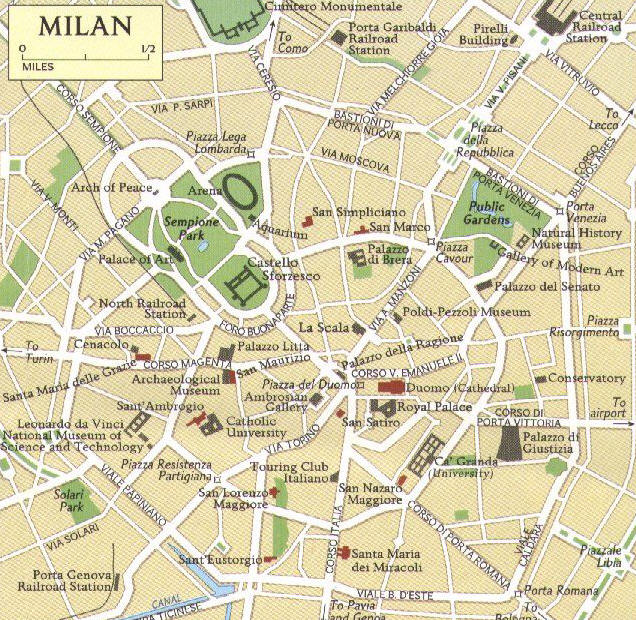 |
|
|
Map of Central Milan |
|
|
There was a good bit of the day left so I went for a walk into town. (I had to use the map in my guidebook but it really wasn't very convenient.) The streets were full of Fiats: I guess we're getting close to the nest. The main attraction in town seems to be the Duomo, which is a huge Gothic cathedral, notable in my opinion, mostly for its gloominess and smell of oldness as much as for its beautiful stained glass windows. I had a bit of a wander through the Galleria Vittorio Emanuele II, but it was just a covered shopping street - what was the fuss about? It was too late to go to the Santa Maria della Grazie to see Leonardo's 'Last Supper': I thought I'd be able to go back to it the next day, but as it turned out I didn't. That's something I now regret.
|
|
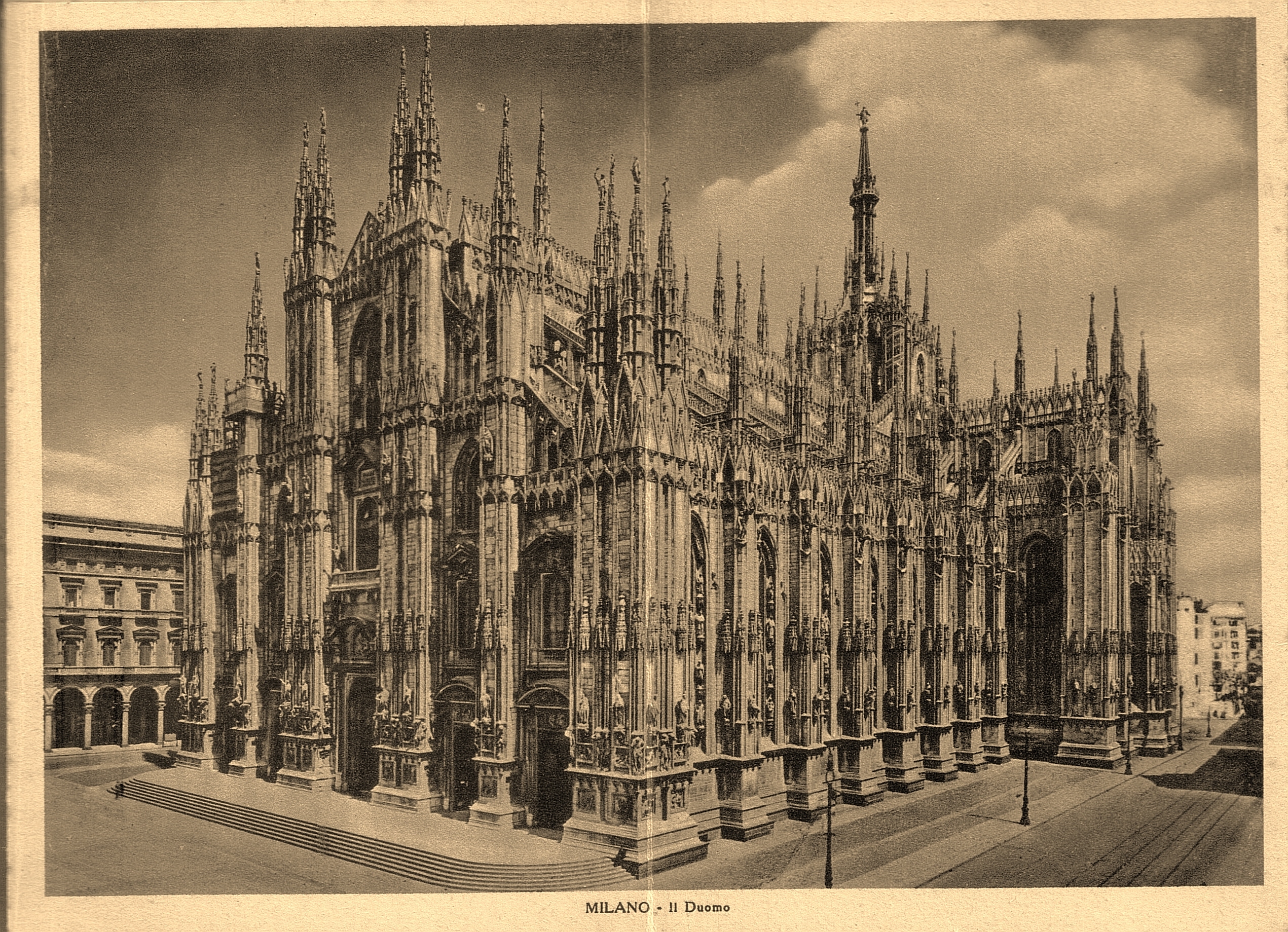 |
|
|
Milano - Il Duomo From the book of postcards Poppa gave me for Milan. (He bought it in Italy during his European holiday 1939-45. The postcard picture of the Galleria V. E. shows Fascist party signs on the shops. Weird.) On the back it says 'This world-wide famed building presents with its numerous turrets and spires an elegant and stately monument. It is externally decorated with 98 small gothic towers and with about 2000 statues. Seen in summer night, with the moonshine playing through the turrets and on the marbles, it presents a fantastic and splendid spectacle.' |
|
|
I went back by way of the central station and stood in a queue to ask about trains to Stresa. Apparently, they leave from Garibaldi, a small station just a bit west of the Stazione Centrale. I decide to go there tomorrow morning and finish the evening with a Big Mac, bacon and chips. Not very Italian, but convenient.
|
|
|
26/10/1996 (Saturday)
|
|
|
Watching CNN on the TV in my room I saw an item about the ship 'Carnival Destiny'. It seems that its arrival in Venice was its delivery to its new owners. It looks as amazing on the inside as it does from outside.
After breakfast I walked to Porto Garibaldi and bought a ticket to Stresa. There were two hours before the train left so I went to the Giardini Pubblici I'd walked through yesterday, just S-E of the Piazza Repubblica, and read a book for a while. Despite it being a bit overcast, it was really quite pleasant. There were plenty of kids running about and people walking their dogs. In fact, other than the language people were speaking, it was no different from any public park back home.
The train trip was interesting. The landscape out the windows became much more heavily forested and quite obviously mountainous. And the character of the villages seemed to change. They seemed more serious somehow that the villages I'd looked out on from the windows of the train to Siena. Perhaps it's just the weather. It's odd to think that if I just sit on the train I'll pretty soon be taken into Switzerland - I was tempted to do just that, but there'd probably be some sort of border formalities that would make it tiresome.
Arrived in STRESA.
|
|
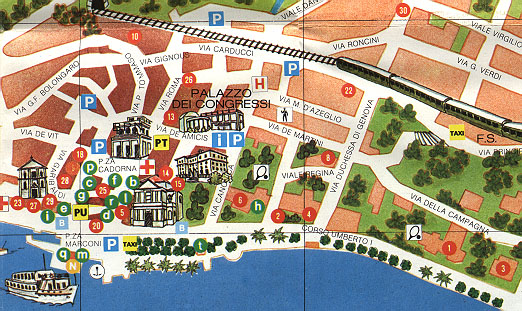 |
|
|
Map of Stresa The ferry goes to the Isole Bella but I didn't. |
|
|
Holiday spots - this one's on the Lago Maggiore - always seem depressing in the off season. This was no exception. Apparently this is where Hemingway recuperated from his wounds and is the setting for his novel. I should read it sometime. There really wasn't much to do or see here, so I think this was a bit of a waste of time. Pity.
|
|
|
27/10/1996 (Sunday)
|
|
|
The end of my Italian travels. Bussed out to Linate airport. Then had to hang around for hours waiting for my flight. Arrived in Heathrow on a gloomy and windy day and made my way by bus (to Reading) train (to Swindon change to Cheltenham) and taxi to the Cotswold Grange hotel. Arrived about 19:45 (GMT!). |
|
